




Atlas Office Landscape is a work system which brings together height-adjustability and collaborative working in one elegant solution.

Combine desks, screens, tables and stowage elements to create spaces that invite collaboration, zones for focused activity or impromptu meetings.
hermanmiller.com HermanMillerAsiaPacific
Your design statement...


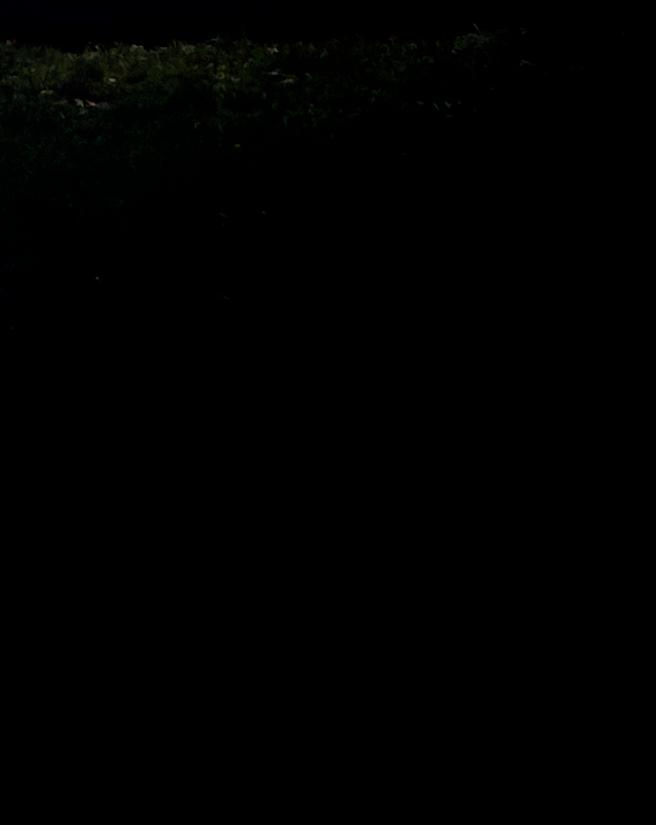












... lies within.

Grand architecture demands grand interior pieces. Refrigeration is one such design element and should speak to who you are. Every Gaggenau piece is distinctively designed, crafted from exceptional materials, offers professional performance, and has done so since 1683.




Make a statement: gaggenau.com.au





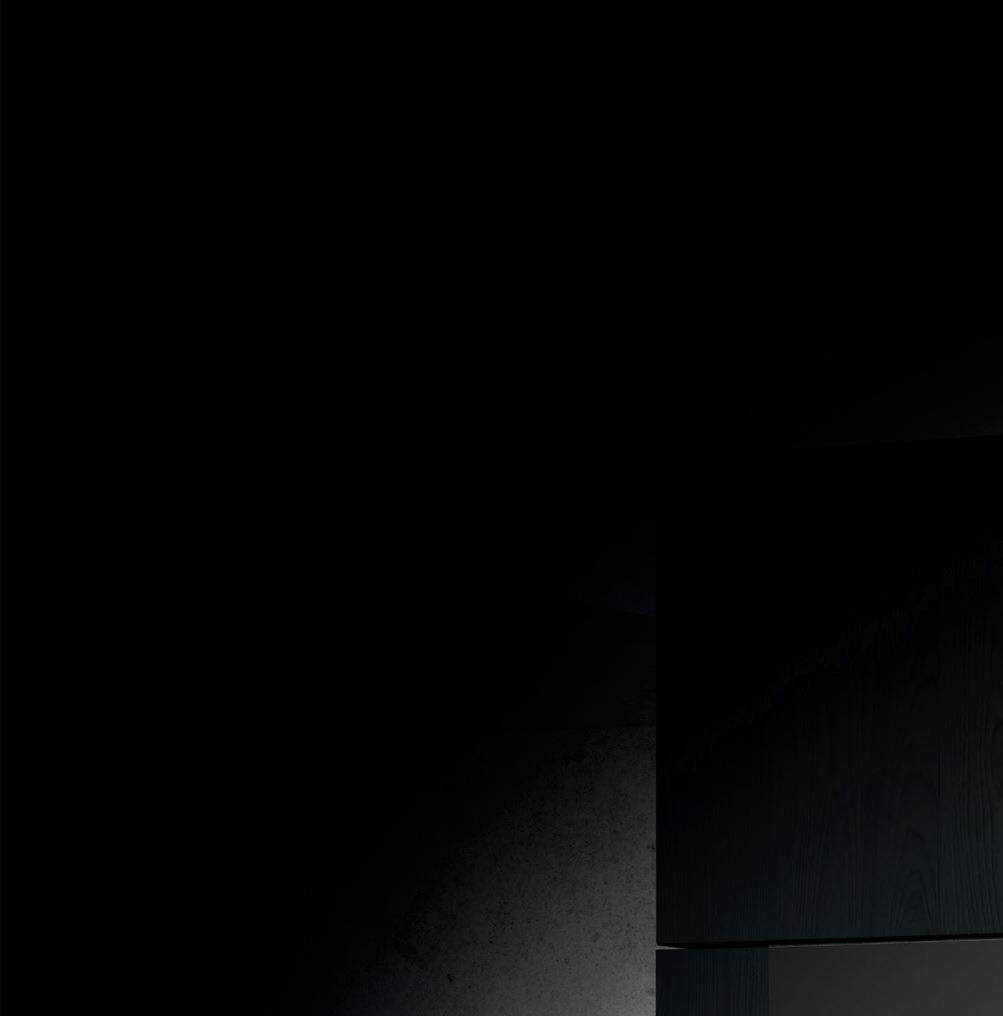
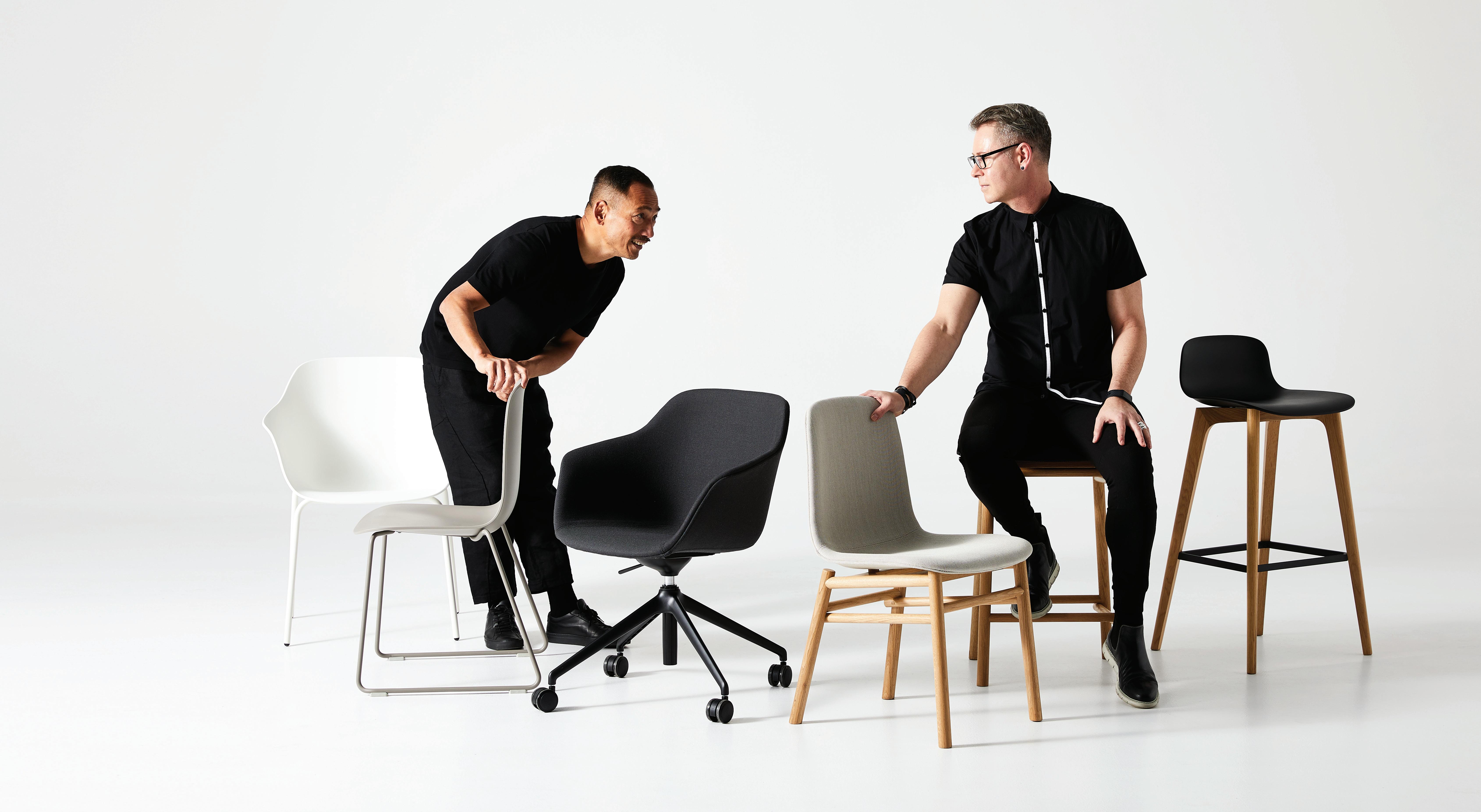











The Bika chair is a minimal slim line stackable seating option that is a game changer for the multi-purpose chair market. It’s seemingly simple structure and soft aesthetic disguises a great innovation in design.

Bika boasts a sleek monocoque frame that is strong, flexible and stylish. The slim design, smooth finish and defined lines give it a modern yet inconspicuous aesthetic.
This frame accommodates interchangeable seat shells in a range of colours and materials making it extremely customisable for the end user allowing them to exercise their creative needs.
The versatile Bika chair is sure to be a favourite across a wide range of sectors.







Have more with less


your
The combination of induction and extraction in a single product where the search for harmony, innovative functions and unique performance, has resulted in an award winning piece.


Elica is available at Winning Appliances, selected kitchen stockists and online at: shop.elica.com.au



All your drinking water needs, All-in-One beautifully designed system. Remove the need for multiple taps in your kitchen with a single, beautifully designed system that delivers boiling, chilled and sparkling filtered drinking water, as well as hot and cold unfiltered water for your sink.
The Zip HydroTap All-in-One offers every water option you need from one multi-functional tap and a single intelligent compact under-bench system. That’s why the Zip HydroTap will be the one and only hydration solution for your kitchen. Discover more at zipwater.com



CEO and Founder
Raj Nandan raj@indesign.com.au
Managing Director
Kavita Lala kavita@indesign.com.au
Editor Alice Blackwood alice@indesign.com.au
Consulting Editor Paul McGillick
Indesignlive Editor Neal Downward neal@indesign.com.au
Brand Director Colleen Black colleen@indesign.com.au
Brand Director Dana Ciaccia dana@indesign.com.au
Business Development Manager
Brune a Stocco brune a@indesign.com.au

Production and Projects Manager Brydie Shephard brydie@indesign.com.au
Production Assistant
Becca Knight becca@indesign.com.au
Accounts
Cassie Zeng cassie@indesign.com.au
Lead Designer


Louise Gault louise@indesign.com.au
Designers Harry O’Donnell harry@indesign.com.au
Julia Gee
Online Manager Radu Enache radu@indesign.com.au
Web Developer Ryan Sumners ryan@indesign.com.au
Indesign Correspondents
Stephen Cra i (Melbourne)
Mandi Keighran (London) Andrea Stevens (New Zealand)
Contributing Writers & Sub-Editors
Leanne Amodeo, Aleesha Callahan, David Congram, Stephen Cra i, Rebecca Gross, Mandi Keighran, Graham Lauren, Andrew McDonald, Paul McGillick, Tracey Ingram, Tess Ritchie, Emily Su on, Pia Sinha, Andrea Stevens
Featured Photographers & Illustrators
Michele Aboud, Elizabeth Bull, Michelle Byrnes, Earl Carter, Haydn Ca ach, Peter Clarke, Carle o Ferrari, Rory Gardiner, Richard Glover, John Gollings, Sam Hartne , Christopher Frederick Jones, Dave Kulesza, Katherine Lu, Shannon McGrath, Chris Moore, Tatjana Pli , Cathy Schusler, Nicholas Wa
Head O ce
Level 1, 50 Marshall Street
Surry Hills NSW 2010
(61 2) 9368 0150, (61 2) 9368 0289 (fax) indesignlive.com
Melbourne
1/200 Smith Street, Collingwood VIC 3066

Singapore
4 Leng Kee Road, #06–08,SIS Building, Singapore 159088 (65) 6475 5228, (65) 6475 5238 (fax) indesignlive.sg
Hong Kong
Unit 12, 21st Floor Wayson Commercial Building, 28 Connaught Road West, Sheung Wan, Hong Kong indesignlive.hk
Join our global design community, become an Indesign subscriber!

To subscribe (61 2) 9368 0150 subscriptions@indesign.com.au indesignlive.com/subscriptions
Yearly subscription: Australia $55 (incl. GST) International AUD $110
Printed in Singapore Indesign is printed with ENVIRO Soy-Based Process Black ink, UV Solventless Varnish and on paper which is awarded an Environmental Management Certificate to the level ISO14001:2004 GBT24001-2004 and Eskaboard and Eskapuzzle produced from 100 per cent recycled fibres (post consumer).
On The Cover

B:Hive – Smales Farm, Takapuna, Auckland by BVN
Here we are: 2020. The year Indesign celebrates 20 years of publishing industry-leading projects and championing great design to a global audience. When the magazine was first started, produced out of a two-bedroom apartment in the Sydney suburb of Woollahra, print was considered gospel.
Back then we couldn’t have foreseen how the information age would force such a drastic evolution in the way we publish, consume and share information. In the year 2020 we find ourselves at an exciting turning-point in what is a rapidly spinning world of progress and innovation. It’s thanks to the boundless energy of our publisher and immense faith of our supporters and audiences that we today bring you Indesign magazine – just as beautiful, strong, insightful and refreshing as it always was. Still the heartland for commercial design in Australia, with a particular emphasis on the workplace –something for which we hold a special passion.
Twenty years on, Indesign the magazine now operates at the helm of a highly interactive stable of brands. From our events –like Saturday Indesign – to our region-leading awards program, the INDE.Awards, and our ever-expanding digital platforms, Indesignlive Australia, Singapore and Hong Kong: we bring your personal stories, creative endeavours and business initiatives to the world in a richly layered, highly experiential format.
Correction
The article The Place-Makers in Indesign #79, pages 76-80, references One Circular Quay Hotel. The design is a collaboration between Crone Architects and Kengo Kuma and Associates who won the design excellence competition. Furtado Sullivan was engaged as subconsultants to collaborate with the design team during June-October 2018.

250,950+ readers engaged across print, digital and social...
indesignlive.com
/indesignlive
@indesignlive
@indesignlive
This year, we invite you to join us for a year of celebrations, because we’re rolling them out across our entire Indesign Media program. Start by saving the date for Saturday Indesign, 20 June in Melbourne, themed Back To The Future. Need I say more?! Go to melbourne.saturdayindesign.com. Also lock in the INDE.Awards Gala event, 14 August in Sydney – where we will pay homage to the Best of the Decade Work Space and Living Space, alongside all our core industry-leading categories.
It’s particularly fitting that we mark our 80th edition with The ‘Workplace 20/20 Foresight’ Issue. We’ve gathered the forces across architecture, interior and furniture design, property and sustainability to bring you all the insights you need to move forward with expertise and vision.
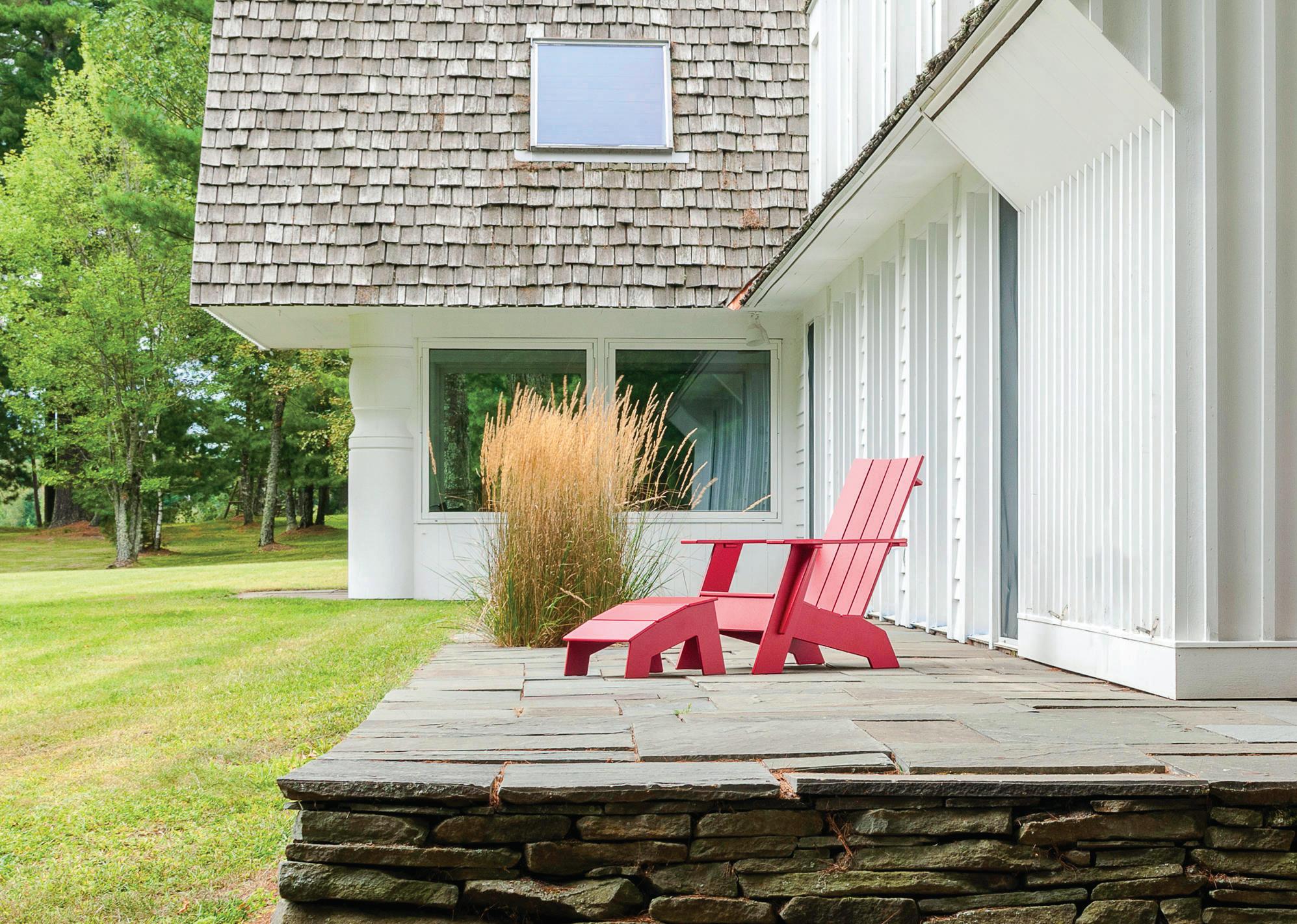
Neil Christopher is design director at Gensler in Sydney and is the Asia Pacific and Middle East practice area leader for financial services firms. His focus is on design, client management and project leadership with clients from a wide range of industries throughout Australia, Asia, the US, Europe and New Zealand. Neil regularly collaborates with the consulting practice in Gensler, delivering on experience-led design strategies.


Mega-Cities
Page 132

Dan Cox’s experience and skill are in the delivery of efficient and intelligent design solutions for Carr’s clients. Working across workplace, hospitality and building renewal projects, Dan leads the design team in the translation of the brief into design outcomes that support overarching spatial and project objectives. Dan and his team have been responsible for many award-winning interior environments. He has also forged a reputation for creating clever, considered and provocative spaces which reflect a brand’s identity while driving profitability and business success.
Graham Lauren is a director of the award-winning Shiro Architects and a former journalist and editor on the pages of the Australian Financial Review newspaper group. He holds an MBA (Technology) from the University of New South Wales in Sydney. His experience, study and personal research have given him a fascination for workplace strategy, and for documenting and transforming workplace knowledge to drive organisational and workplace learning, for its many applications, using the best technologies ever invented for the purpose.
Paul McGillick’s career as a writer and curator has extended from architecture and design to the visual and performing arts. His 18 books include five on the architecture of South-East Asia. For more than 12 years he was editorial director at Indesign Media where he edited Indesign magazine and was founding editor of Habitus magazine. He has contributed essays on industrial design, urban design and Australian architecture to many books; and has edited a monograph on the architecture of the National Gallery of Australia. Paul is currently a consulting editor on Indesign magazine.


Rosie Morley brings a wealth of specialist hospitality experience to her role at Carr. After completing a Bachelor of Interior Design at RMIT, Rosie’s career has been largely focused on hotel and hospitality design, both locally and internationally. Rosie’s portfolio is abundant with high-end hotel projects, particularly from her years spent in London. These projects range from new-build to heritage refurbishment, from branded hotels to new-concept boutique offers. Her breadth of specialist experience and knowledge in hotels and hospitality is highly regarded.
Page 140
Page 122
Page 92
Page 140
Neil Christopher Design Director GenslerFRESH NEW ABSTRACT GEOMETRIC TILE DESIGNS TO BE USED INDIVIDUALLY OR IN CONJUNCTION WITH AUTHENTIC WOOD PLANKS
A CONCEPTUALLY DEVELOPED COLLECTION OF LUXURY VINYL TILES

For more inspiration visit polyflor.com.au

The ultimate industry cheat sheet. 29-44
Big thinkers and creative gurus. 49-67
INDESIGN Luminary Ross Gardam, Stephen Crafti, Elisa and Grazia Manerba, Davina Rooney
Provocative, innovative and inspiring design.
75-117
QUT Peter Coaldrake Education Precinct Building, Brisbane by Wilson Architects and Henning Larsen
Mercury, Auckland by Warren and Mahoney
Carpe Diem at Barangaroo Tower 2, Sydney by International Towers with Geyer
Melbourne Airport Headquarters, Melbourne by Foolscap Studio
Modus Head Office, Cronulla by Vitale Design
Australian Unity, Melbourne by Bates Smart
Indesign’s 20/20 Foresight Workplace Design Report.
121-146
Featuring
B:Hive – Smales Farm, Auckland by BVN in association with Jasmax Mapien, Brisbane by COMUNiTI Beach Energy, Adelaide by Unispace PSLab, London by JamesPlumb
With special comment from Graham Lauren of Shiro Architects
Neil Christopher of Gensler
Rosie Morley with Dan Cox of Carr


The POCO range by Gareth Ashton is inspired by the enduring pin-lever design, this elegant tapware delivers a new shape featuring a minimalistic handle and thin cylinder. A simply beautiful range that will enhance any room with its graceful forms.

335 Ferrars St, Albert Park, VIC
Ph: 03 8696 4000
1E Danks St, Waterloo, NSW
Ph: 02 8572 8500
94 Petrie Tce, Brisbane, QLD
Ph: 07 3369 4777
12 Sundercombe St, Osborne Park, WA
Ph: 08 9208 4500
Wellness really dominates the conversation in workplace design. We see this very human value commoditised into design tools, clever interior inclusions, rating systems and more. It’s gratifying to see the take-up – from thoughtful colour schemes to connections to nature, high quality amenities that address ‘me’ time and ‘we’ time, and even environmental monitoring systems. Wellness is a community health program.
But what of that more introspective aspect of wellness? Reconnective disconnection, isolated re-energising? Taking time to contemplate the dark side of happiness... that is, sorrow?
Shanghai-based Hip-pop Design Team’s Jiyu Spa in China’s coastal Jiangsu province challenges the idea of wellness in a very private and moody experience. It’s one of glassy boundless spaces, of carefully curated light and shadow. “Visitors are immersed in the large-scale peaceful picture, where the senses are awakened by the visible world, and the feelings and images once ignored in life are represented here,” says Hip-pop Design Team.
The team uses transparency, reflective glass and falling water to dramatic effect. Moments become freeze-framed, your three-dimensional depth-sense falls away to leave you alone with your raw emotions in a four-dimensional sphere.
The secret is in the glass boxes and waterfall: layers of glasses form a dreamy visual effect. As the individual moves through this space they encounter the waterfall which, thanks to the reflective glass, surrounds the individual. “In such a mysterious and profound place, people who are increasingly restless… will be slowly melted by the gentle water,” the design team comments. A whole-self antidote to the more mainstream measures of wellness at work.


Benjamin Hubert is at his most exciting when he’s blending typologies. The industrial designer and founder of LAYER has partnered with fashion designer Christopher Raeburn on Canopy, a collection of furniture made from upcycled parachutes. The duo explores the shared design process of furniture design (Hubert) and Raeburn’s evocative use of parachutes in his brand’s fashion collections. Surplus ‘drogue’ parachutes – used to slow an aircraft’s landing – have been transformed into rocking chair seats, with the existing construction of the parachute giving the chairs a distinctive, highly-tactile quality. Ex-military parachutes have been used to create a matching rocking chair and room-dividing screen. “Together we have translated [RAEBURN’s] iconic use of parachute material in the fashion world into an exciting exploration of form and materiality in furniture,” says Hubert.
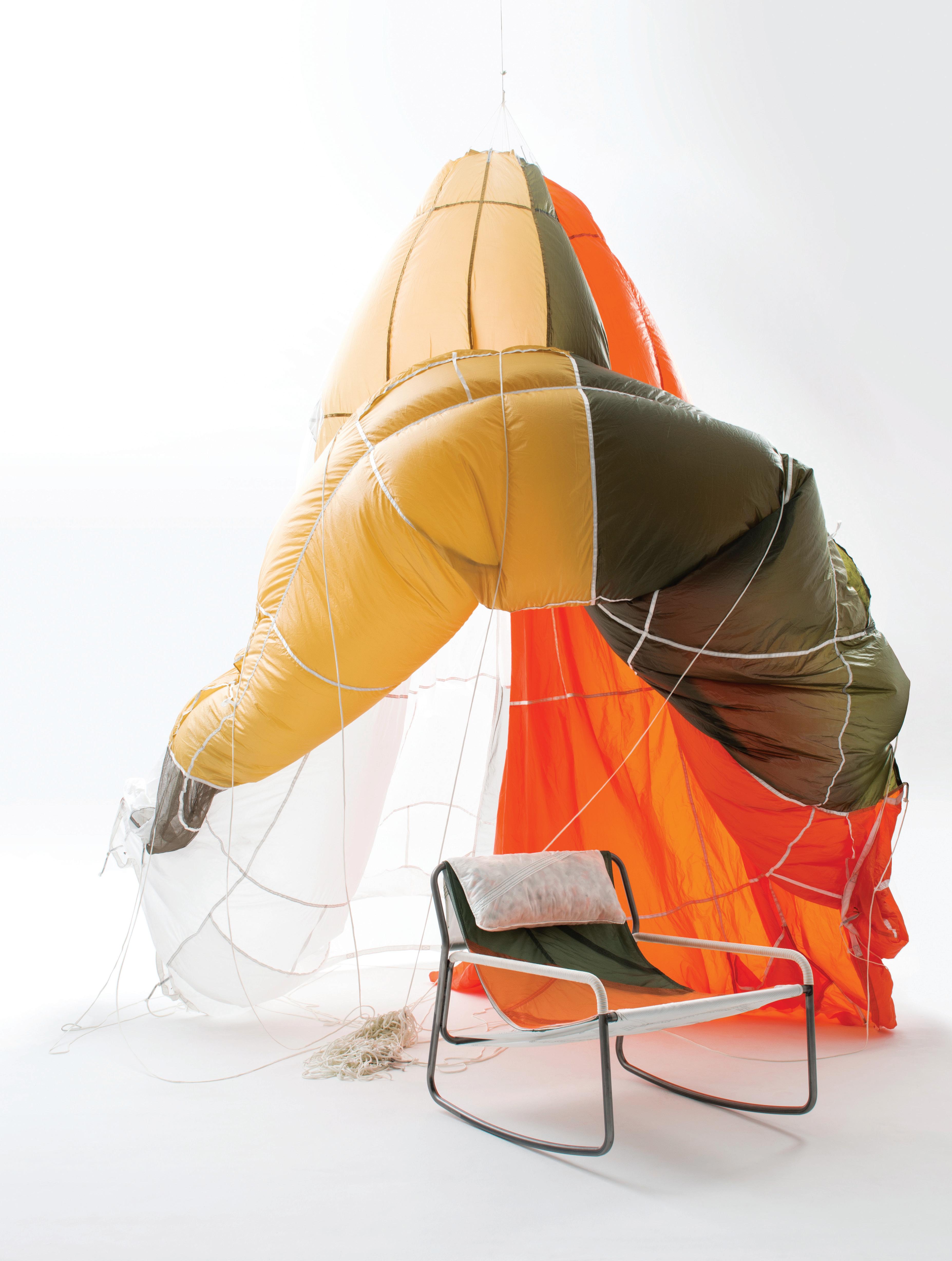


To create functional objects for people in their most intimate spaces requires a very visceral and expressive touch. From Prospero Rasuli’s earliest years of creating for the bathroom “it was never about design or an object, it was always about art”. Perhaps the biggest turning point in Rasuli’s practice was when he met the inimitable Alessandro Mendini, with whom he began designing objects “which were sculptural but more of practical use”. In order to design for the bathroom – and the likes of Valdama with whom Rasuli has a close and long-lasting relationship, the blending of disciplinary boundaries has been the key to their shared success. Rasuli’s ne orchestrations of colour, form and material become “symbolic” forms of communication. A sense of “harmony and so ness” for example, “communicate that there is more to an object than just being functional”. Because while the bathroom might operate as a tfor-purpose space, it’s also an area of great in uence in our lives. Valdama is available in Australia through Parisi.
Indesign Blu Dot
When it comes to furniture design, timber continues to commandeer the top spot for popular material choice. Through the Buddy Collection, Blu Dot raises the material’s appeal even further, with a fresh-yet-familiar chair design that is appealing for its timeless versatility and hug-like form.

Aptly named for its ability to ‘befriend’ many contexts, Buddy’s design is e ortlessly au courant with a gentle nod to the past. Its moulded plywood back is like a little hug, gently wrapping around the curved timber seat. The use of bent plywood is an unconventional juxtaposition against the solid timber base. The intention is that it sits just as comfortably in a commercial setting as it will in a residential space.
The design team started by building a full-scale prototype as a way of working through visual detailing and important comfort adjustments. The team then re ned the base to its simplest form while retaining the rigidity and strength necessary to withstand the rigours of commercial use. If Buddy isn’t the ultimate all-rounder, we don’t know what is!











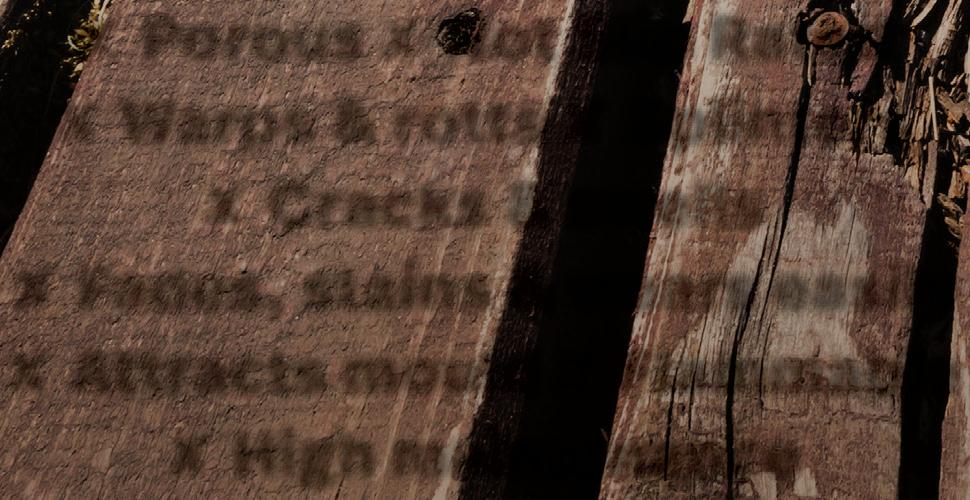

In an ideal workplace, sta are engaged, productivity is high, the place feels good and it is t-for-purpose. What this looks like, of course, is constantly in ux. As ideas around work and life change, technology advances, where and how a team functions comes up for discussion, so too do work environments – and workplace furniture. One brand that has acute knowledge of this is Accent Furniture, which is celebrating 50 years in the business.
Founded in 1969 by Neil Kennard on the Central Coast of New South Wales, three generations later the family business is still actively servicing the corporate, education and healthcare sectors with quality modern furniture. As head of business development, Alby Kennard, explains: “Neil’s same passion for design lives on and we now service both corporate and government sectors across Australia with a complete range of collaborative, educational and workplace furniture solutions, that enhance team engagement and increase productivity.”
In a small and competitive market, this is no small feat. It re ects a company that has paid attention to the needs, issues and challenges of corporate environments, and who have drawn on their experience to nd solutions that not only work but better our environments. This is noticed too, and Accent have “established a reputation for manufacturing innovative and high-quality modern furniture solutions”.
Accent isn’t just celebrating 50 years though; it’s celebrating the future. “We have worked with the design market for a long time now and we will continue to showcase our products to the industry. We have a number of exciting new partnerships in 2020 which we can’t wait to show you, bringing you the best in European design with the exibility and quality of Australian manufacturing,” says Kennard.
This year they have launched two new products. A prime example of Accent’s commitment to dynamic design is the Aira chair range. Designed by Giovanni Baccolini, Aira is a comprehensive collection of breakout and visitor chairs to suit any commercial, public, educational or home environment. And ‘any’ really means ‘any’. This eclectic range comes with endless options – from sled and pyramidal bases to denim upholstery or wood, varnished steel to bi-colour options, arms, no arms, or just a stool.
The second range is the Copenhagen Workstation. With solid natural ash legs in a splayed triangular pro le, it is an elegant desk system that o ers a fresh and sleek structure to any workspace. And with frames designed and manufactured in Italy, and worktops and accessories manufactured in Australia, it’s another hybrid of highend design, quality and exibility.
If these are the o erings for 2020, it is exciting to think what the next 50 years holds. Because workplaces – all places – are only going to continue to change.

Indesign Cult
Today’s workplace product designer is faced with a high-stakes challenge. It’s no longer enough to design with aesthetic charisma. A product must perform with a versatility that brings new meaning to the word functionality. When faced with complex challenges, the extraordinary simplicity of nature provides plentiful inspiration. As is the case with Chameleon, a table system designed by Adam Goodrum which adapts to its environment with seamless speed and ease. Chameleon’s uniquely engineered design allows users to work with multiple size and shape formations. Central to this is a structurally refined axis-joint that enables 15-degree frame and leg articulations. This single mechanical solution is the key to Chameleon’s modular adaptability, making it configurable in multiple formations. Its shape-shi ing abilities also extend into two height variations – allowing for sitting and standing scenarios. A truly evolved product to combat today’s agile work environment.
Indesign Planex
When you’re dealing with open plan o ce environments, zoning is everything. There are plenty of clever design tools for achieving this, but we’ve been pretty impressed by the quadruple-capacity of Planex’s Linea range. It’s a freestanding storage solution (below, in Group GSA’s Ausgrid t-out in Sydney), that not only de nes spatial parameters but also delivers on sustainability with an AFRDI Green Tick Platinum A-level certi cation. On top of that, it’s tted with six millimetrethick Acupanel®, an acoustic-rated soundabsorbing material. Pretty impressive for a Melbourne-made solution, produced using locally sourced materials.

What really de nes a space and how we might use it? We asked this question when we came across the Kinuta collection by Karimoku Case Study. The story of this collection is told through its setting –the Kinuta Terrace apartment project in Tokyo. Completed by Keiji Ashizawa and Norm Architects, the apartment features this rst collection which draws heavily on the natural references of the apartment’s connected courtyard. It’s an attempt to invite nature in, through both design language and materiality. Detailing is reminiscent of the structures seen in Japanese temples and gardens.
It’s a gentle and enquiring approach, a rethink on the signi cance of furniture in de ning space. It also puts the emphasis on the fact that a space is what you make of it, and furniture can really set the tone for how we choose to move through our spaces and our days.


With exibility, movement and autonomy built into the very fabric of the o ceplace, we can now individualise our workstations while also operating within more informal and collaborative settings. Flexibility is a key theme for Inclass – a rising star in the contemporary contract-grade workplace furniture solutions space. With chairs like the ultimately ‘multi’ ALTEA collection (le ) by Jorge Pensi Design Studio. Mix and match base types, backrest heights, upholstery options. Other collections include the Simon Pengelly-designed VARYA on castors and with storage baskets – ideal for freeformat training environments; Jonathan Prestwich’s rounded ESSENS table with power, data and wireless charging facilities; and Studio Inclass’ ESCALAS modular lounge series with a high-back version for privacy and so ened acoustics with charging requirements.

Comme des Garçons may not be your style, but its radical beauty holds a hidden message for anyone working within a creative paradigm. It was in the mid-to-late 1970s that Rei Kawakubo was starting to create ripples in fashion in Japan. A few years later, in 1982, her designs presented in Paris polarised the audience. Heading Comme des Garçons for almost four decades, her unique vision has inspired the retrospective of her work, Collecting Comme, at National Gallery of Victoria (NGV). “You could say that a large percentage of the fashion press were affronted, while others recognised Rei’s ‘radical beauty’ in [her] designs,” says Danielle Whitfield, NGV curator of fashion and textiles. “It was certainly a strong shift from the folkloric styles shown at that time.” Her ‘lumps and bumps’ collection for SS97 saw removable padding inserted to create an entirely new silhouette for women, with a shift away from the hourglass model to one that was distorted. “Rei presented a completely different relationship between clothing and the body, questioning the notion of the traditional female beauty and form,” says Whitfield. Alongside show-stoppers like this ‘Coat and trousers’ from the 2 Dimensions collection (Runway RTW, Fall 2012, Paris Fashion Week), are Rei’s ‘Sheik Punk’ designs, including a red PVC skirt, worn with fishnet stockings and a tuxedo-style jacket adorned with shiny PVC lapels. “You could easily say that Rei Kawakubo is one of the most visionary fashion designers of the 20 th century, shaping the way we look at fashion, both then and now,” says Whitfield. “This show is really exploring how a vision can impact on so many, whether you’re a designer or simply one who appreciates new and innovative ideas.”

SYDNEY 5/50 Stanley Street

Darlinghurst +61 2 9358 1155




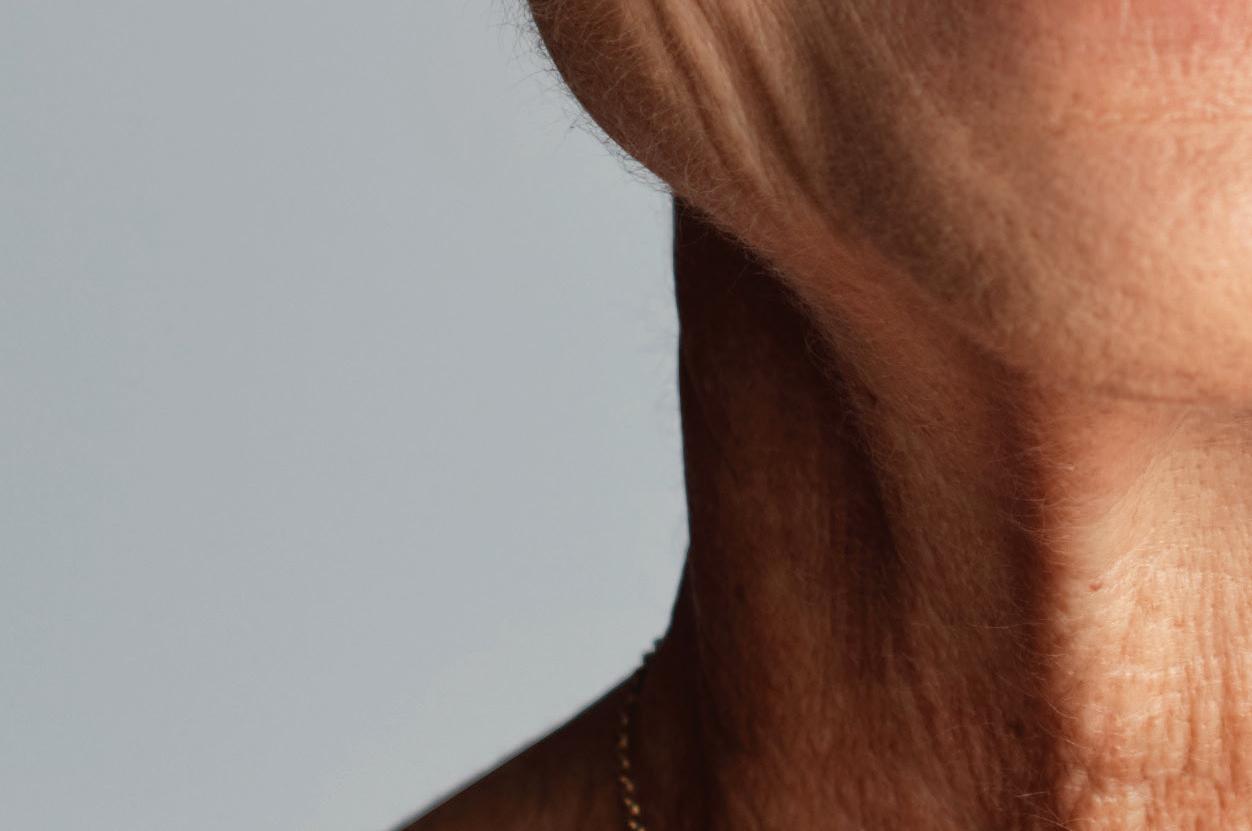
MELBOURNE 11 Stanley Street
Collingwood +61 3 9416 4822
ownworld.com.au/senior-living














The ability for flooring to navigate you through di erent spatial zones fi nds its foothold with the likes of Expona Superplank.
Indesign Billiani
A combination of function and stylistic appeal are the utmost requisites for restaurant furniture design. Keeping this and Billiani’s experience in large installations in mind, Eurest Austria chose the brand as the main supplier of chairs and tables for Quartier Sechs, the food zone in the new business district, Austria Campus in Vienna. The Quartier Sechs features chunky blue and green chairs designed by Francesco Faccin; Doll and Hippy chairs with steel legs by Emilio Nanni; wooden doll bar stools together with high Puccio tables; new Layer armchairs by Michael Geldmacher and upholstered lounge chairs from the Croissant and Spy collections. By no means a small footprint to furnish, Quartier Sechs boasts a surface area of over 10,000 square metres with 1800 seats, making it one of the main food courts in Europe. Photo: Carletto Ferrari Photography

There’s something to be said for subtle zoning devices that allow you to move seamlessly between spaces while still feeling ‘in place’. Supporting that shi in physicality and mindset is Expona Superplank, a conceptually developed collection of Luxury Vinyl Tiles. It’s distinctive for its beautifully authentic wood planks and abstract geometric tile designs which can be laid solo for simplicity or in conjunction with one another. Curated by a team of Australian interior design experts, the range speaks to the aesthetic re nement in both patterning and colour choice. From a practical pointof-view, an innovative two-millimetre gauge allows Expona Superplank to be installed alongside two-millimetre sheet ooring, providing seamless ooring solutions which have the ability to bridge zones without compromising on style and durability.


From an abandoned quarry to a high-polish hotel experience, the InterContinental Shanghai Wonderland Hotel by Chinese design studio, Cheng Chung Design (CCD), is a medley of mining cues mixed with 21 st century luxury hotel culture.
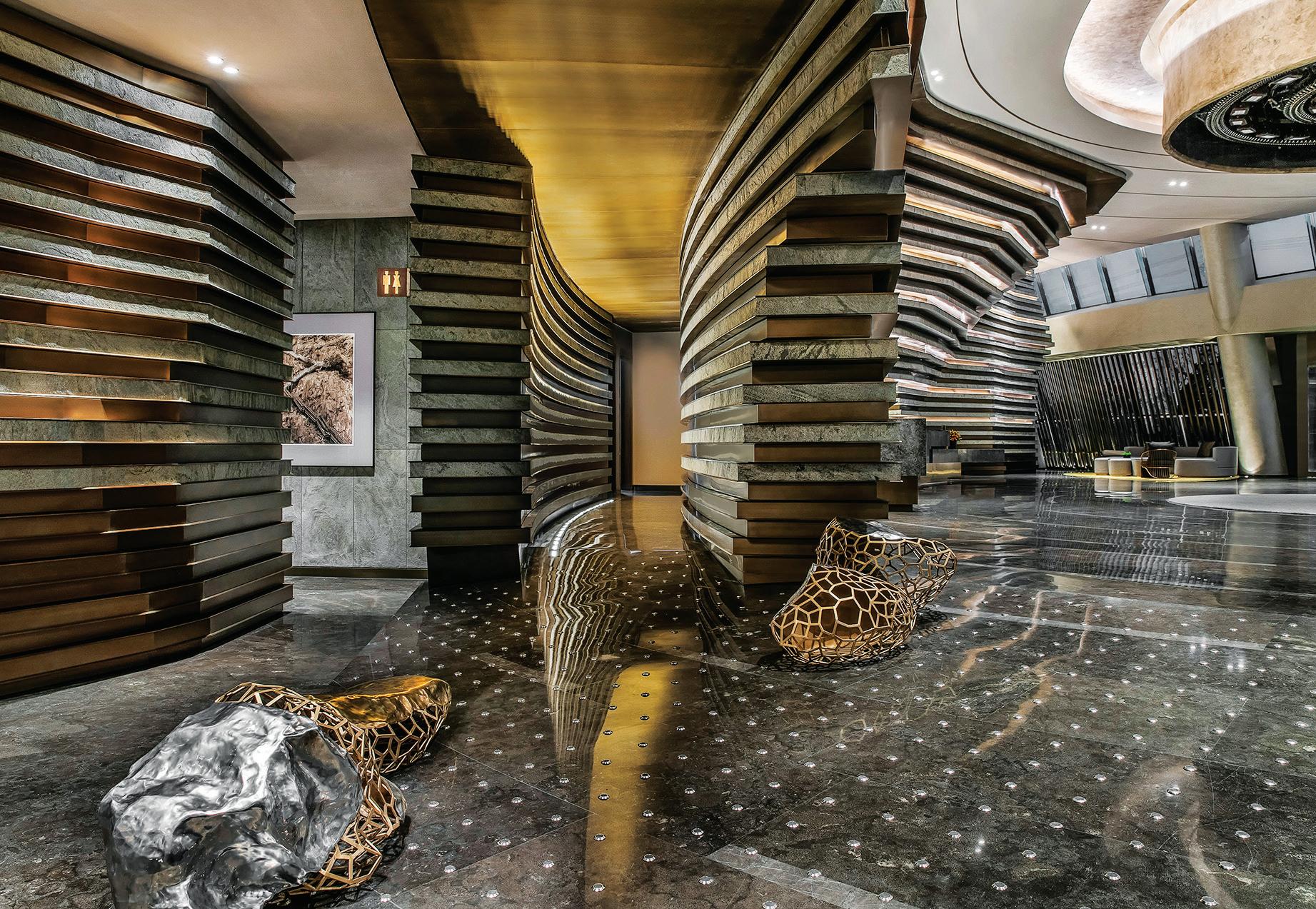
The hotel has been constructed inside an abandoned quarry, and ambitiously built beneath ground-level with part of it submerged beneath water, too. With an interior design experience that references everything from wild rocks to vertical cliffs, visitors might mistake themselves for being on a luxurious cave adventure.
Dedicated to “reshaping the relationship between architecture and the natural environment through hospitality design”, CCD has used this project to comment on the changing relationship between humans and nature – and where better than in the remnants of a quarry?
The experience starts in the lobby where a series of towering cliff faces emulate the natural appearance of bed-rocks at different heights. “The design inspiration is from the horizontal and vertical
textures formed by the flooding of magma due to crustal movement,” notes CCD. The raw and the precious come into play with a bronze wall referencing the colour of miners’ tools – an evocative melding of humanity with nature.
Other zones in the hotel include the cave-like ballroom where shadow and LED light interplay to create a dreamy starlight effect. At the base of the site is an indoor pool area, where stalactitelike feature ceilings and pillars give the effect of a Biquan cave. Submerging visitors into a watery wonderland is the undersea restaurant as well as select guest rooms. Immersed in crystalline, watery hues and surrounded by flickering fish, CCD intended the effect to be otherworldly.
By virtue of its ambitious subterranean design, the project was “confronted with numerous challenges and difficulties in landscape planning, material usage, and mechanical engineering”, notes CCD. The outcome, nevertheless, evokes a memorable combination of the raw and rocky, with an elaborate douse of high glam.
Indesign SUPAWOOD Architectural Lining Systems
Whatever the interior fit-out challenge, SUPAWOOD remains flexible and solutionsdriven to meet specific and complex project needs. Its architectural wall and ceiling lining systems are designed to solve tough design problems without increasing cost, complexity or compromising on looks. Manufactured in Australia for 20 years, SUPAWOOD products put safety first while retaining a decorative finish. Its panels, slats and beams are the least combustible timber products on the market today. It can meet all requirements for Fire Group 1, 2 and 3 for any interior area within any class of building. SUPAWOOD’s feature linings can also achieve any project’s acoustic and Green Star environmental performance requirements.
Product SUPASLAT custom curved panels in SUPAVENEER ‘featured grade’ Blackbutt natural timber veneer


Project Shopping centre ‘Market Hall’ extension, Robina, by Buchan Brisbane, photo: RixRyan Photography

Product SUPACOUSTIC custom slotted acoustic panels in SUPAFINISH Fusion Maple on ceiling and curved wall, internal panels – fire retardant MDF substrate
Project
Product Supaslat MAXI BEAM LED-lit beams in SUPALAMI Striped Mahogany, WAVE BLADES ceiling in SUPASURFACE Oak RNO Project IGA Romeo’s Food Hall fit-out, Sydney by Saunders Global, photo: JadaArtDynamic and collaborative workplaces, custom solutions and responsible design that thinks global, acts local. These are the values that are increasingly sought a er when it comes to commercial design and the context within which Living Edge announces Derlot Group: a new venture with chief designer and founder of the Australian-owned, multi-disciplinary design studio Derlot, Alexander Lotersztain.
Building on Lotersztain’s 15 years’ experience in leading the commercial furniture market and his truly collaborative and humancentred approach to design, Derlot Group is a new identity that brings together the best of Derlot’s furniture brands – Derlot Editions and Les Basic – and welcomes new and exciting furniture collections that centre locally sourced, custom and bespoke furniture solutions that are adaptable, versatile and uniquely Australian. And have a global outlook.
Exclusive to Living Edge, the exciting new venture was, as Lotersztain puts it, a “natural progression”. It represents two brands that have aligned values and agree on what it means to service an increasingly conscious, global-thinking and dynamic industry. “With a focus on locally made products and a shared commitment to the architecture and design community, I believe Derlot Group and its brands make a timely compliment to Living Edge’s portfolio.”
In terms of product o ering, Derlot Group is as extensive as it is exible. Priding itself on authentic, future-forward design, they provide furniture, lighting, and products for the contract, hospitality and education sectors. They also specialise in design schemes for
human-centric, agile and active environments that are uniquely Australian and where, as Lotersztain says, “collaboration is the most important and rewarding part of the process.”
As a result, the collection is de ned by “a level of modularity and exibility that has come to be part of Derlot Group signature”. Alongside award-winning collections such as Derlot Editions’ Twig, Prisma and Les Basic homework line, Derlot Group launches with four new products that exemplify the two lines coming together: the Caterpillar Modular Sofa, which comes together in segments to o er complete exibility for all kinds of meeting places and contexts; Strap Seating Collection, which ts indoor and outdoor hospitality, residential and commercial living spaces; and the extensive range of Tonne and Yeti tables.
Derlot Group is also, of course, looking ahead. “I think the future is all about responsibility with a strong focus on sustainability,” says Lotersztain. “At Derlot Group we are making inroads and investing in ways to address our environmental footprint. From our “Thinking Global, Acting Local” agenda, seeking manufacturing partnership across all our markets, our network of manufactures now extends to partners in Australia, New Zealand, USA, Italy, China, servicing each region we operate in.”
So, for workplaces that call for dynamism and collaboration, an architecture and design community that wants solution-based design and bespoke capabilities, and as the demand for socially and environmentally responsible design that is global in approach grows, Derlot Group with Living Edge delivers.


 Words Paul McGillick Portrait Photography Elizabeth Bull
Words Paul McGillick Portrait Photography Elizabeth Bull
Ross Gardam is softly spoken, but with a subtext suggesting he has always known where he’s going, where he’s come from, and why. That’s probably not entirely true, but he certainly gives the impression that every step he has taken in what has been a successful and highly productive career has had its place in the larger scheme, like the pieces of a jigsaw puzzle. But if this is the case, it suggests unusual focus from an early age – a focus which is evident in the beautifully resolved products which come out of the studio.
“Like a lot of industrial designers,” he recalls, “I grew up around making objects and building things. My father was an engineer who ran a brick-making factory. So, I was exposed to the manufacturing side of that business. It wasn’t a huge facility, but there was a metalwork workshop and a timber workshop. I spent a lot of time there tinkering.”
At high school he took a subject called technology which, he says, he enjoyed and “felt like a good fit”. It seemed logical to move into the industrial design program at Monash University which he found “really interesting because it took you through art history and design and ran across quite technical aspects”. But however clear-eyed he may have been, he didn’t at that time envisage owning his own furniture and lighting business.
In fact, on graduation and for the next seven years he worked in two areas which he has largely left behind: interior retail design and environmental design (outdoor space, wayfinding and signage).
This he did first with a couple of companies in Melbourne, then in London for two smaller, but similar companies. “I had spent my adult life in Melbourne, so I wanted to experience being in a different city,” he explains. “I had travelled a lot by that stage. I had travelled to 20 or 30 cities by the time I went to London. It wasn’t a sense of wanting to travel, it was living in a different space.”
After two years in London, Gardam decided it was time to do his own thing. He returned to Melbourne in 2007 and started his own practice, which was initially a continuation of the environmental design consultancy, Spaceleft, which he had established in London but with a greater emphasis on product design.
The name came from the idea of looking at the space left around a problem, or the space around an object which helps to define that object. For the first two or three years he continued to do interior work, which he enjoyed, but also aimed to develop two or three products a year. These, he explains, were very much experimental pieces, “mainly around material use and single-process manufacturing”.
Why do we do what we do? For Ross Gardam, it’s that moment of intimacy and surprise that drives his work: the magic that comes when you fall in love with a design.
“It’s the emotional perspective that I am really interested in and the way people interact with it. The small moment of surprise or that intimate moment you have.”

Ross Gardam, designer/founder, Ross Gardam studio

Out of this evolved the rigorous process Gardam now follows, beginning by looking at various aspects including how it is going to be used and how it works in space. “The work is definitely informed by material and process,” he explains. “And I have worked with a number of different processes that are quite old, like glass-blowing and ceramics, more traditional arts and craft.” This has led to an interest in blending traditional craft with contemporary manufacturing, “looking at ways I can bring that to a more contemporary space”.
In more recent years the studio has become interested in the user’s emotional connection to the product. This entails analysing how a product can engage with someone at an emotional level – “ideally to create a sense of surprise or wonder and hopefully bring a sense of joy”.
Gardam gives an example of the recently re-engineered Ora Desk Lamp which provides a 360-degree orbit rotation of the shade due to a magnetic joint. He concedes that it is not necessarily the most cost-effective strategy and “it probably wouldn’t even register in the top 10 solutions from a pragmatic perspective”. But, he continues, “it’s the emotional perspective that I am really interested in and the way people interact with it. The small moment of surprise or that intimate moment you have with a product is really important”.

Eventually, Gardam moved on from being a sole practitioner and there are now eight people working in the studio – five industrial designers, an office manager (with a furniture design background) and two makers. The business changed, he says, when he began employing people; this was followed by another change about four years ago when they set out to create the Ross Gardam brand.
Despite this, Gardam feels there is an identifiable aesthetic which is contemporary, but also “an absent marker of time – it could have been made 40 years ago, in the present or 40 years in the future”.
Another part of the aesthetic is what he terms as emotional functionality, or the emotional connection with the user. By way of example he references the Polar Desk Lamp. “It talks to pieces from the 1940s right through to now and, I think, in the future. It is as much about shade as it is light. The arm can be completely removed –a functional aspect of the product that invites interaction.”
He also sees the work as being about place. “We have a unique set of resources in Australia,” he says. “We have a unique set of manufacturing processes. That has shaped my work. It is not as simple as selecting a local timber. There is more complexity to it than that. There is the manufacturing base around it and I am committed to local manufacture.”
While their international presence grows – for example, in the United States and through trade fairs such as Milan Furniture Fair and ICFF – the studio nonetheless continues to work in a small, local market. “So,” says Gardam, “we are talking about lowervolume runs. We are more interested in making a more precise, lower-volume piece with the manufacturing we have, [rather] than a mass-produced object.”
Meanwhile, he enjoys his new role as the coordinator of a creative team, as part of a collaborative process which continues to produce products unique not just for their innovation and imaginative use of materials, but also for the way they seem able to touch the people who use them.
The soft radial curve of the Polar Desk Lamp provides relief to the grid of concrete block-work in RITZ&GHOUGASSIAN’s Edsall Street project. As Jean-Paul Ghougassian says, it both “complements and softens the harshness of the interior spaces”.

Ours is a profession that should lead change, not future proof against it, says Stephen Crafti.
Terms such as future proofing have their moments in the sun. For the last couple of years we have regularly used these words, and often in conjunction with sustainability. It’s as though by making architecture and design ‘proofed’ for the future, nothing needs to be done for the foreseeable lifetime of a building.
Although the idea seems entirely appropriate, given the concern for the environment, future proofing is extremely difficult to achieve. Let’s face it, architecture and design – as well as fashion and decorative arts – is about change: some voluntary, some due to changes in society, technology or environmental. Because these industries are inherently linked to humans and their interaction with the world, and these things are constantly in flux, change is really inevitable. Yes, people can install a lift in their homes to ensure it remains responsive to their needs as they age, but surely there are few, if any, homes that remain in aspic. The lift may stay (although even this might be upgraded over a lifetime), but the entire décor is likely to change. If it didn’t, we would all be scrambling for work!
We also see future proofing thrown around in reference to the workplace. A presentation to the client including these words perhaps puts them at ease that the money spent on the build is a good investment, not just for now, but importantly for the long term. But a static workplace is rarely, if at all, presented to a client. To state the obvious – workplaces have changed significantly over the last few decades, and they’ll continue to evolve in line with changing work practices. The separate enclosed office was the norm at one point. Then we saw a move towards activated breakout spaces that could be used for either informal meetings, or simply areas to chill out with work colleagues. Other workplaces changed more dramatically, with staff persuaded through a design to forgo territorial boundaries. These shifts in workplace design could not have been foreseen a decade-or-so ago.
Rather than using the term future proofing, perhaps the term ‘flexibility’ is better suited to our purposes. It makes more sense to imbue a design with flexibility. So, for example, a child’s bedroom can easily morph into a home office after they fly the coop. Likewise, it makes sense to include retractable acoustic-treated doors between two rooms that can be left open to form one larger space to cater for greater numbers. But to say this feature is future proofed is setting up unrealistic expectations for a client.
What seems more realistic is to be able to provide spaces across all design arenas that can easily adapt to change. Any modifications to a design will entail a cost. Replacing finishes and fixtures, as many do over a period of time, is ingrained in design. Very few, if any, expect a design to last for an eternity. Clearly if it did, this would be a miracle – particularly given the rapid evolution of technology and, relative to this, how we live and work.
The other concern around future proofing is the move by architects and designers to play it far too safe. Wanting a design to be as relevant in 20 or 30 years’ time is an enormous ask for even the most insightful designer.

You may be able to predict certain shifts in the design arena – whether it’s domestic, workplace, hospitality or in the educational sector. But there are changes every day, along with innovative discoveries, that make concepts redundant. Technology is moving at such a rate that it becomes difficult to create a design for the long term.
So, let’s stop leaning quite so heavily on the term future proofing and realise that our profession is built upon change – some incremental, others causing a paradigm shift that necessitates a completely different way of thinking. Please contact this writer if something is completely future proofed, whether it’s a home or a workplace. I feel confident in saying that if it’s exactly the same in 50 years’ time, I will eat my words or, more correctly, digest this highly overused phrase.
 Words Mandi Keighran Photography Courtesy of Manerba
Words Mandi Keighran Photography Courtesy of Manerba

Manerba Spa might be an historical Italian company, founded in 1969 by Sergio and Federica Manerba, but the brand’s focus is firmly on the future – specifically, the future of the workplace. It’s interested in how the company’s traditional values of craftsmanship and Italian style can inform a new vision of the office as an adaptable space that reflects technological, social and cultural evolution.
Today, as Manerba enters into its sixth decade, it is lead by sisters Elisa and Grazia Manerba, alongside their parents, who still work in the company. “It was like growing up in a big family,” says Elisa, of her lifelong association with the company. “I have known this world since I was a child, and the history of the company is the history of our family.”
Elisa, who studied economics and commerce, is the Italian and foreign sales director, while Grazia, who studied engineering, has dedicated herself to developing and optimising products. “We have
very different roles, but we have a shared vision,” says Elisa. “Together, we take the steps we need to allow the company to grow.” Their shared vision – which they presented at Milan’s Salone del Mobile in 2019 – is of a ‘boutique’ office, with a range of highly customisable products dedicated to enabling the exchange of ideas. In this vision, the workplace is a comfortable and welcoming environment, taking inspiration from domestic design sensibilities. “This is a space that is dreamed of by each of us,” says Elisa. “Thanks to devices, people can now work anywhere. In a workplace, the most important thing is the social spaces where people can meet and discuss.”
When Manerba launched in Australia in February 2020 with James Richardson Furniture, they did so with the three product families that most characterise this ideal: Undecided, Apollo and Stem. “These are

In today’s workplace where social spaces take precedence, Elisa and Grazia Manerba are curators of ‘exchange’. On the eve of their launch in Australia, we share their story.Page 58-59: Sisters Elisa and Grazia Manerba are leading the company into its sixth decade. Above: The highly configurable Stem modular bookcase system by Philippe Nigro for Manerba. Opposite: The playfully proportioned Undecided collection by Raffaella Mangiarotti and Ilkka Suppanen for Manerba. Page 62: Apollo, the modular system of scalable desks by Shane Schneck for Manerba.
Their shared vision is of a “boutique” office, with a range of highly customisable products dedicated to enabling the exchange of ideas.
 Elisa and Grazia Manerba, Manerba
Elisa and Grazia Manerba, Manerba
products that reflect our philosophy of ‘fluidity’ and personalisation,” says Elisa. “We want to bring that vision to Australia.”
Undecided is a playfully proportioned collection of award-winning seating that reflects Manerba’s focus on comfort and a domestic touch in the workplace. The collection’s name comes from its modular pillow structure that can be easily reconfigured to change seat height, privacy and colour to suit an ever-changing environment – whether office, airport lounge or hotel lobby.
Apollo is an affordable, modular system of scalable desks inspired by the sisters’ boutique vision. Similarly, Stem is a modular bookcase system that can be configured to meet the exact needs of its users.

“Today, working often happens outside of the ‘common’ working space, in areas such as hotels and airports, and so the workplace follows a more dynamic way of working, which changes very quickly,” says Elisa. “So, office furniture has to adapt to the user and create a beautiful and comfortable workplace.”
In the coming years, Elisa and Grazia believe that the workplace will be an even more bespoke space – with colour playing a big role in defining and individualising space. “Colour can personalise any environment,” says Elisa. “Our ‘colour project’ is the result of our research into new trends, materials and surfaces. As a result, we have applied colour to all our collections, starting with our Linea partition walls that divide a space with colour. The research
continues with our Stem bookcase system, in which components can be combined to create new, custom chromatic compositions.”
Like colour, sustainability is another key concern and, for Manerba, this is an approach driven by longevity. Products are designed to be reused, recycled, and durable where recyclable materials – including timber, fabric, aluminium, glass and cork – are selected over plastics. The company is also ISO 14001 and FSC certified. “Every time we introduce a new collection, we put sustainability first,” says Elisa. “This has always been in our DNA.”
One of the company’s most ambitious and experimental sustainable initiatives was Office+Retrofit, in which designers, architects and other creatives were invited to imagine an eco-friendly “second life” for Manerba’s old stock furniture. In doing so, they created new collections using old furniture. Sovrappensiero design studio, for example, transformed old desk caddies into plant trays and turned surplus seats into colourful mismatched benches.
“The office is in constant change,” says Elisa. “We don’t work the way we did 50 years ago, but nor do we work the way we worked last year. At Manerba, we know how to transform and evolve – and that is what the future workplace needs.”
manerbaspa.com, jamesrichardson.com.au

More modern, more flexible, improved acoustics, and nice to look at from all sides. With acoustically effective, electrified, freely configurable panels on the inside and outside. The possibilities for using the Bosse human space cube 4.0 are as varied as your wishes – perfect as a meeting room or individual office, as a quiet area or for teamwork. For further information please write to asia-pacific@dauphin.com.au
I was waiting on a phone call. It was a Friday, one of the decade’s last, and everything seemed to have unravelled. Outside, school children were on strike. Their prime minister hectored “more learning [...] less activism [...] go to school.” But it was thin, hot air. Resources Minister Matthew Canavan, meanwhile, flung contempt at some as young as eight. “The best thing you’ll learn going to a protest is how to join the dole queue. Because that’s what your life will look like.”
There it was. Again. A future of positive climate transformation apparently thwarting a future of professional self-sufficiency. My inner Greta Thunberg rankled. The receiver clicked. I wanted a hot take.
“It’s hard to keep focus on what is really important here,” says a woman’s voice at the end of the line.
“Do you mean, intergenerational equity? That fight?”
“No. Hope,” says Davina Rooney, CEO of the Green Building Council of Australia (GBCA).
I hadn’t expected it. After all, we’re more prone to brooding these days – I guess one of the penalties of an environmental awakening is the feeling of living alone in a world of wounds.
“I notice hope more and more, and it brings with it a renewed sense of what it means to be a community,” Rooney continues. “As a driver for action, it has changed a huge amount. Look at where we were on public awareness a year ago.” Her tone is warm – steady, reconciliatory, even buoying. I can hear how such a voice would be useful in driving the sustainable transformation of something as turbulent as the built environment sector.
A month prior, Rooney had confidently put it to use launching Every Building Counts, the latest practical pathway for sustainably transforming Australia’s built environment. The report’s 75 recommendations to federal, state and territory, and local governments strives for net zero emissions by 2050 and has been widely applauded for recognising the role of industry and endusers in meeting Australia’s Paris commitments.
“This is a real milestone for the GBCA,” Rooney tells me. “If you look back at the Council’s inception, it was very much an owner-led technical response to the challenges. I find it heartening that, now, there is a real focus on the diversity of views we seek from different partners to steer that change.” Recent partnerships with the Commonwealth Bank of Australia and Woolworths, for instance, not only use the Council’s proprietary Green Star as a benchmark for the design and construction of real estate assets the brands occupy corporately, but also use it to understand the performance of these buildings and the retail fit-outs in their operation. With the commercial design sector moving at breakneck speed to deliver transformation in this space, “it is phenomenal”, says Rooney, “that the consumer-facing brands in the market, and not just the property owners, are now bringing a huge degree of impact, momentum and passion.”
It’s self evident this cresting wave gathers force from renewed consumer activities, in addition to the emergence of genuinely new business models, particularly in the circular economy space.
Last year while kids rallied against heads of state, Australia’s infrastructure portfolio took top billing in global sustainability audits. Despite the dire outlook, Davina Rooney says we must remain focused on what is important.

The rate of amplitude, however, appears to suggest other positive contributing factors at play.
“It’s certainly more difficult to measure,” she muses, “but new cultures of leadership in the workplace are making a profound impact. I think the term ‘culture of leadership’ is apt here.”
As a term, I didn’t put much stock by it anymore – not easy to turn deaf ears on senators heckling school children away from picket lines. But I ought to have remembered Australia’s nine-year victory lap (and counting) as frontrunners on the Global Real Estate Sustainability Benchmark; the consistently stirring performance on the Dow Jones Sustainability Index; and the daily reports of homegrown AECO talent taking innovative and sustainable strides abroad.
“We have the power as well as all the technology needed to rise to the challenge and arrive at that net zero 2050 target. With government and all our partners in industry through the supply chain, we know that our buildings use 50 per cent of the nation’s energy, contributing about a quarter of our emissions. Policy and action are parts of solving this puzzle – but celebrating real leadership is too. It’s why we launched the Net Zero Building Commitment with the World Green Building Council, to partner with and celebrate Australian organisations committed to taking their building stock to net zero for 2030. Groups like Dexus, Multiplex, Monash University and 18 other GBCA members give us reasons to be optimistic. Celebrating leadership is important to maintain the enthusiasm and help scale-up this success.”
When asked to describe what this enthusiasm looks like, Rooney’s focus draws inward. I hear of what lies just beyond her window: business start-ups mixing with multinationals on outdoor furniture, co-sharing spaces with generous plantings, big squares with natural light, people abuzz everywhere. “The workplace scene of the future is where all this energy is coming. Dynamic individuals working
differently in spaces. Our own tenancy in the Barangaroo precinct is a really good example of this. We look at it like ‘property-as-service’ –with a much smaller tenancy, we blend easier with other neighbours, sharing spaces and amenities with other innovative organisations from across the precinct.”
“A hands-on opportunity to lead by example?” I ask.
“And for people power. Precincts like this are very emblematic of the future of the workplace, tapping into not only the desires of individual workers, but also their businesses and tenancies at scale.” Rooney enumerates how the tenancy mix had been able to aim for net zero waste, explains what a bio-digestor is, how various projects have already achieved 90 per cent of their net zero journey.
I’m used to coming across terms like this – enhanced transparency framework, low cost abatement strategies, mandatory performance disclosure – in corporate agendas. But often, their missions feel complicated by a tacit suspicion we’re trying to solve problems with the same kind of thinking that created them. In any case, my chariness was thawing listening to Rooney’s clear and fluent delivery, mingling these with other concepts from the lexicon of affective science – cognitive empathy, collaborative intelligence, desire, optimism.
“You know, I look at the Youth Climate Strike... and I see it again, hope. Research tells us it’s that emotional engagement underpinning the desire for change. So I think the question for so many of us is, how do we design for hope? Let’s inspire people to design that future – for all of us.”
GBCA is located in Carpe Diem at Barangaroo Tower 2, Sydney. Read about this visionary fit-out on page 92.
gbca.org.au

Among Australia’s more exemplary 6 Green Starrated workplaces is Arup Sydney with temperature comfort control in the form of swirl diffusers, active indoor climate monitoring, materiality savings through an integrated fit-out process.



On the 20th anniversary of Stylecra and Arper’s partnership, the two brands celebrate a shared journey of authentic, relevant design and look ahead to the next era of collaboration in workplace, residential and commercial design solutions.
In 2020, Stylecra and Arper celebrate 20 years as partners –making the Italian design brand one of Stylecra ’s longest running European partnerships. This is no small feat and certainly reason to celebrate. But what’s more impressive than endurance in the Stylecra /Arper story is that this has been two-decades of synergy.
Since 2000, they’ve continued to provide the Australian market with everything from versatile classics – Catifa, Duna and Pix families, through to more recent collections, including Cila, Cila Go, Kiik and Zinta. So that in 2020, Arper features in a great diversity of t-outs across Australia.
What’s the secret? Quite simply, values. As Tony Russell, Brand Director at Stylecra , puts it: “Arper and Stylecra have a shared commitment to authentic design and evolving our brands to anticipate industry developments, technology and design trends.”

This doesn’t mean there hasn’t been change – Stylecra evolved from specialising in desking in its iteration in 1953, to o ering a diverse range in the current market. Meanwhile Arper transformed into a dynamic brand that now o ers a broad range of furniture, screens and accessories, as well as modular solutions adaptable for all settings. But it is change that has been aligned. Driven by a shared appreciation for enduring, human-centred design, as well as a commitment to evolving alongside technology and embracing new material innovation, Arper has remained in close sync with Stylecra .
Speaking to Arper’s diversi cation is its Work/Life and So (er) themes, which, as Russell says, shows Arper’s “in-depth understanding of the psychology behind workplace, educational and public space design and the changes in this industry”. As the domestic and professional spheres converged and the digital age triggered the need for stillness and balance, Work/Life and So (er) blurred the lines.
While a so er approach to living, learning, and working has always framed Arper, here it has been renewed for the present. Achieving that ne balance between people, place and object is Zinta, which
brings familiarity to public settings. The importance of calming colours, forms and materials that feel good, and exible, comfortable spaces that nurture is emphasised with Cila Go, Planesit, and Stacy. Meanwhile Aava, by Finnish designer Antti Kotilainen, transforms an essential, e cient form into one that evokes sensitivity through the texture and warmth of wood.
So (er) began with the Catifa family though, and the simple idea of an undulating form to support the body. From the original, sleek design of Catifa 53 by Lievore Altherr Molina, the range now encompasses seven collections, reinterpreted for di erent eras, aesthetics, and functions – from higher backrests for work, to crisp, casual designs, generous proportions to fresh colours. Synonymous with Arper itself, Catifa epitomises the brand’s ability to evolve with integrity.
For Stylecra – guided by providing original, quality furniture and product that evolves with changing workplace needs, Arper
continued to hit the mark. When the Australian market demanded workplaces that were more akin to domestic spaces, Stylecra introduced Stylecra HOME, or when Australian designers called for exibility to suit the local market, Arper delivered. The local program, o ering a broader collection of upholstered Arper items on a short lead time, was even initiated as a result.
And in 2020, a shared love for quality design with a contemporary mindset continues: Arper is evolving beyond furniture for workplace environments to providing ‘whole systems’ – with Paravan, a sculptural system with a range of accessories within Paravan Mood, a prime example.
As Russell explains: “This is a step away from Arper’s traditional collections. We’re excited to see the brand continue to diversify and refresh their o ering to the design world and we look forward to joining them on this journey.”




Education is a gateway to unlocking potential, developing life skills and entering the workforce. Queensland University of Technology’s (QUT) Peter Coaldrake Education Precinct Building, designed by Brisbane practice Wilson Architects and Danish firm Henning Larsen, is a gateway in both the physical and figurative sense. The building itself is a major feature of QUT’s Kelvin Grove campus and a facilitator of students preparing to become teachers.
“The building is pivotal to QUT in terms of location as it brings together the education faculty, the existing library and a major pedestrian spine that connects the busway to the campus heart,” says John Thong, director of Wilson Architects. “It also provides a memorable, inviting place that enhances student engagement and offers teaching and learning spaces that support contemporary pedagogy and technology.”
QUT’s educational approach emphasises real-world learning experiences that reflect the physical and digital nature of the present and the adaptability required for the future. As in the
contemporary workplace, technology and agility play an important role in contemporary pedagogy. Technology needs to inspire, prepare and equip students to become teachers; agile spaces need to support teaching and learning, empowering students to thrive.
Wilson Architects and Henning Larsen incorporated these technological and agile working requirements into the design of the building to help students and teachers achieve the best possible outcomes, and to create an engaging environment that serves as a entrance to the campus. The building incorporates formal teaching areas and social learning spaces that all QUT students can access, offering a hub for students who may not cross paths otherwise.
The Education Precinct is located on the main path through the campus, just a short walk from the busway. Zigzag sunshading on the exterior of the building provides a distinctive appearance and helps modulate natural light and solar gain. The six-storey building is articulated into three volumes on glass podiums that rise progressively to allow the sense of the external landscape to flow
As we move towards an open-loop mode of working and learning for life, education environments become physical and figurative gateways to future aspiration.
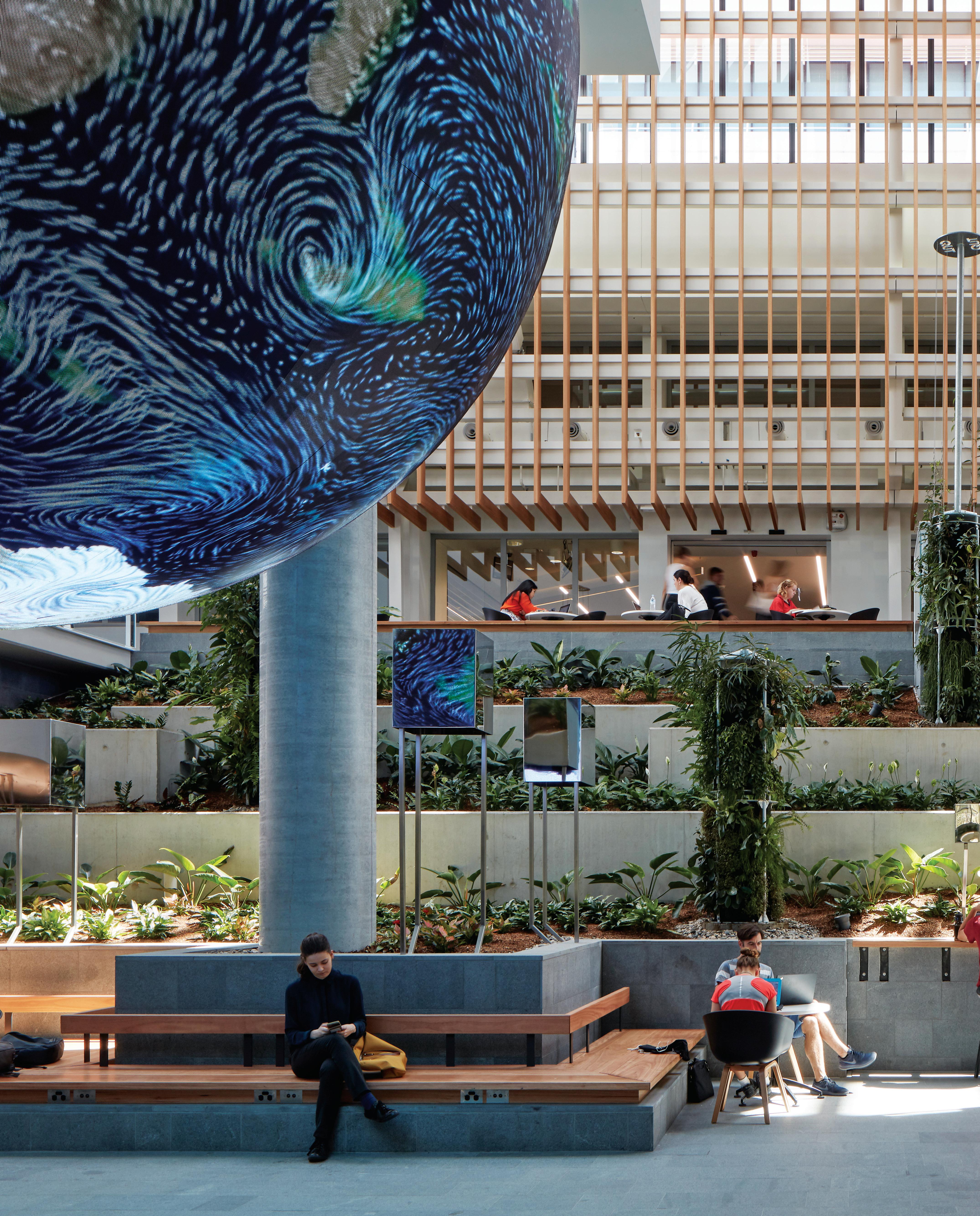
Within the heart of the Education Building a five-metre LED sphere hangs suspended across two floors, offering students new opportunities to engage and interact with visualisation technology.

through. Glazed walls and stone flooring minimise the transition from outside to inside, where a terraced garden flourishes beneath the atrium skylights. The planting provides a respite from the South East Queensland climate, and the biophilic design aids wellbeing by helping to reduce stress, foster relaxation and improve productivity and creativity.
The terrace garden also negotiates the level difference between the Education Precinct Building and the adjoining library. New openings in the library building connect the two learning hubs, enabling direct circulation, and timber fins disguise the existing façade.
A variety of social learning spaces, from amphitheatre seating to lounges, benches and individual and communal tables, provide students with opportunities for collaborative and individual work,

creating an academic space that supports life beyond the classroom. “We wanted to create an environment that supports many different ways to learn. Flexibility was key, and we planned for a variety of learning situations and new teaching methods,” says Jakob Kurek, partner at Henning Larsen.
A giant, digital LED sphere hovers over the ground floor and is a showpiece of QUT’s commitment to applying technology to enhance the student experience. Developed with Pro AV Solutions and Leyard, the sphere can serve as a dynamic learning and teaching tool, providing a digital surface for streaming student and teacher content. It is complemented by an interactive digital LED video wall on level one, and a drop-down screen and high-resolution data projector above the amphitheatre seating.
Students and teachers can also stream content onto visualisation walls within the teaching rooms, which the design team worked closely with QUT to devise. Members of the Faculty of Education and Facilities Management teams trialled teaching spaces over two years, determining how they can best be configured for face-to-face and online learning while also incorporating audio-visual equipment and other technologies to encourage creative and collaborative learning. This translated into a range of flexible rooms to suit different styles of teaching. They vary in size and seating, and sliding glass doors enable a selection of rooms to become larger or smaller. Faculty workspaces are accommodated on two floors of the building and are designed like neighbourhoods. They integrate a mix of activity-based work environments, balancing academia’s need for interdisciplinary, collaborative work with spaces for individual, concentrated tasks. Natural materials and nature-
inspired hues continue to evoke the surrounding landscape, and contribute to a warm and inviting, biophilic environment.
The Oodgeroo Unit is QUT’s Aboriginal and Torres Strait Islander student support unit. This is located alongside the workspaces on level three with a visual connection to an external yarning circle, fire pit and native garden (complete with edible plants and bush tucker) on level one. The top floor of the building is a function space, offering expansive views of the city and surrounding suburbs.
The Education Precinct Building has proven popular not only with Faculty of Education students, but students across all QUT faculties and campuses – many of whom will travel to Kelvin Grove to study and socialise in the inspiring, engaging, technology-rich environment.
wilsonarchitects.com.au, henninglarsen.com


Auckland
by Warren and Mahoney Words Andrea Stevens Photography Sam HartnettEnergy retailer and 100 per cent renewable electricity generator
Mercury has united its Auckland team of over 560 people from three offices into one, central Newmarket site. Moving from a fixed-desk environment to an activity-based working environment has quickly transformed people’s daily experience and work style.
In this new location, business units once separated and siloed are now mixing and talking more, gaining a deeper and more holistic knowledge of the business. Empowering teams and individuals with greater freedom, mobility and choice, the agile environment promotes wellbeing through movement and access to not only public, bright and social settings, but also to quiet and contemplative ones. Within months of the move, an internal survey found 83 per cent of Mercury people enjoyed working in the new space.
People at the heart of change
“The project was founded on a singular vision of having the freedom to do our best work together,” says Sarah Holt, Mercury’s workforce strategy manager. “We held interviews, workshops and surveys, which gradually revealed how individuals and teams could set themselves up to do their best work. This grass roots feedback informed our strategic brief with four key aspirations: collaboration, flexibility, wellbeing and openness – decision criteria that informed every step with true clarity of intent.”
Since the change process was so crucial to the project’s success, Mercury enlisted the help of Roz Sowerby and Sarah Gardner from The Change Shop to help set up the governance and structure for the whole relocation project.
Moving into an agile environment is rarely a ‘turn-key’ experience for a client. For Mercury, two years of pilots and team input precipitated its ambitious shift to agile.

“People are at the heart of change,” say the pair. “This sort of project has to be business owned and led, as no one knows the business like Mercury [does].”
From the beginning, people helped to shape the story, so the design and relocation teams could understand how to best to integrate people, technology and property.

Some of the insights from early engagement were from the customer care team, which needed more one-on-one conversation settings and immediate access to amenities due to their rostering model. Today, they are located in the heart of the space close to the kitchen amenities and provided with clusters of technology-enabled booths on each floor. This team solves queries faster due to this tailored setting, integrated technology and easier access to other sources of knowledge within Mercury.
In addition to receiving feedback from specific teams, Mercury set up training projects and piloted a shared workspace for people leaders. Given first-hand experience, these individuals could genuinely lead by example, sparking authentic conversations within their teams about what the change of work style meant.
Each manager considered how they would lead a mobile team, how their team would connect, interact and how they would induct new people. “The pilot started a snowball effect,” says Mercury’s Sarah Holt. “It required a real growth mindset from everyone.”
It was a big change for people who were used to their own private desks with drawers and paper storage. “We had to tell them they no longer have their own desk, they can’t put things on the wall, and they need to share desks and cupboards. We had to start this conversation early, a good year-and-a-half before moving in.”
Everyone knew the tagline and the four aspirations of the strategic brief. Mercury ran ‘just in time’ communications throughout the
process, and quick pulse checks, so everyone knew what they had to focus on at each stage without information overload.
The 6300-square-metre tenancy spans the top three floors of 33 Broadway, Newmarket. Opening to a central atrium with glass balustrades in lieu of curtain wall glazing, scissor stairs connect the six floor plates to promote movement and incidental meetings. A large grandstand stair in the atrium spans from level five down to the social hub at level three. This brings the whole team together for events, deploying AV to connect with colleagues in other centres. As well as designing for behavioural change, Mercury’s own people were involved in designing the physical environment. Warren and Mahoney’s interior design leads Holly Campbell and Arron O’Hagan listened closely to the specialist needs of staff.
“Design for wellbeing is at the heart of the Mercury work strategy to ensure that comfort and health are supported by the physical environment,” says Campbell. “Our design theme was ‘nature mirrored’, a nod to the sustainable energy provided by Mercury.” Extensive indoor planting, generous natural light and external views, high volumes of fresh air, end-of-trip facilities and electric vehicle charging all contribute to the building’s five Green Star rating. Holt was part of embedding the new changes with constant communication at team meetings, via digital noticeboards and the intranet, plus videos demonstrating the new way of working. “I think the success of the process was also helped by continuing support and communications for another four months after the move,” she says. “Today, we’ve got an equitable setting that supports freedom of choice. This place creates a buzz and empowers people to work more dynamically.”
warrenandmahoney.com

Dressed in soft tones, the fit-out gives a feeling of spaciousness and clarity. On the top floor, dichroic film applied to the boardroom glazing adds a pop of colour and representation of energy.

With wellbeing at the heart of Mercury’s new workplace strategy, comfortable seating and booths are spread throughout with the flow of each space designed to be agile – for exploration and integration beyond teams.



High up in Tower Two International Towers is a new, connected two-level workplace curated for the needs of a neglected sector of the business community. It is the brainchild of Liam Timms, International Towers’ fund manager, developed in collaboration with Geyer partner, Robyn Lindsey. “I looked at the market,” he says, “and it had a gap of quality where there was a lot of very average product for established businesses of 20-50 people.”
It is a part of the market, he explains, that has a lot of very talented people who have started their own businesses. But they are fully established, not start-ups. The start-ups, Timms points out, “will go and chase the co-working”. But these small-to-medium-sized established businesses often find themselves “in these awful white plasterboard boxes where someone has very crudely carved a floor and done a very low-end job and thrown a few primary colours around to make it look attractive”.
The big end of town, because of its scale, can afford the gyms, wellness rooms, parent rooms, fancy boardrooms, etcetera, which serve to attract the best talent. But the smaller businesses have to
compromise. They need a meeting room, but can’t afford a wellness space. So, Timms put himself in their shoes to establish what facilities they would need to support themselves. “How could we scale a shared economy,” he says, “a shared facility arrangement between a bunch of high-performing, talented, diverse businesses and give them the best in business facilities?”
The result is a community of 10 tenancies, each with its own dedicated space, but with an amazing range of shared facilities.
Timms gives the example of the Green Building Council of Australia, the first to move in. It has only 300-square-metres of dedicated space, but it shares 500-square-metres of activity space (various kinds of meeting and work rooms) and another 500-squaremetres of public or community space – a wellbeing room, a parents’ room, four kitchens (including a commercial kitchen for large functions), four print rooms, a 20-person boardroom and various informal meeting areas. Each of the tenancies’ interiors is 6 Star Green Star rated. All of this, he says, “goes to them being able to build their own brand recognition with their own customers”.
International Towers and Geyer give new meaning to the term ‘third space’ with a unique communitybased working model at Sydney’s Barangaroo.
Timms points out that International Towers delivers the space complete, including an Australian Good Design award-winning technology platform to bring it all together, enabling spaces to be booked either o their phone or o their screen. “All they have to bring with them is their laptop computer,” he says.

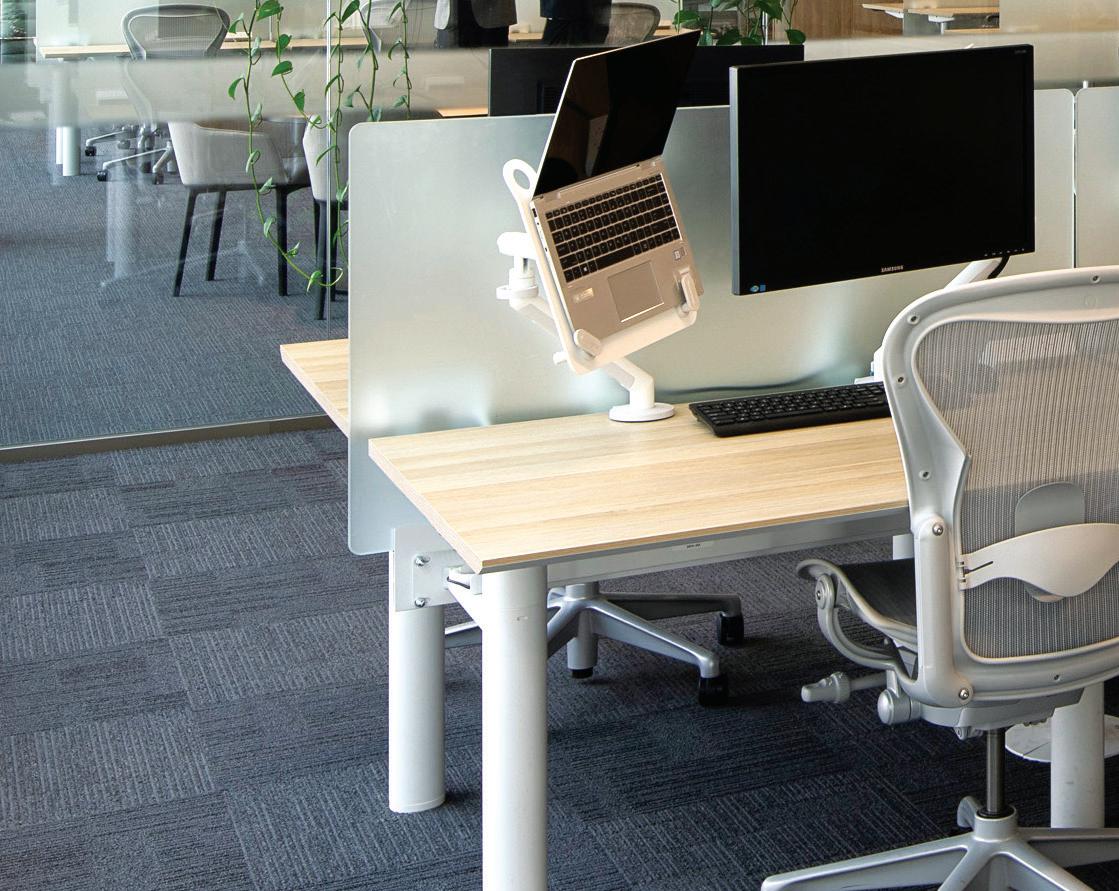

This new concept is indeed driven by the notion of community –not just because of the shared facilities, but by virtue of the way the 2500-square-metres floorplates have been planned. Connection is the key. There is nowhere on the floorplate where you can’t see out to the amazing view of Sydney Harbour. Tenancies and the various ‘analogue’ and ‘analytical’ activity spaces are defi ned by fully glazed walls and nothing is built to the perimeter. Timms points out that part of the psychology of the space is that nobody owns the perimeter – not even the boardroom.
The idea is to drive a sense of connection. “Shared views, shared light and a shared subconscious idea of a be er community,” says Timms. “When you encourage connection, you encourage be er outcomes for people.”
One of the master strokes is the 100 per cent Indigenous greenery throughout, including the li lobbies. There is vertical hanging greenery throughout, but also horizontal hanging greenery running at ceiling height. This o sets any sense of hardness from the glazing, but also so ens the space and mediates the glazed connections between businesses, creating a so , dappled light.


The other master stroke is the Companionway, the direct link between the two levels. “I didn’t want to see another staircase,” says Timms. “I wanted to create a proper connection.” He has borrowed the nautical expression because, on a boat, the companionway connects the upper and lower levels. And, he points out not only is it the safest part of a boat, it is also the place where you put someone new because they can see everything from the Companionway. “It’s where all the cross-over happens,” he says.
It is really an open connection with astonishing views of Darling Harbour and beyond to the Blue Mountains. Beautifully cra ed, it is not meant to be a workspace (there is no power support for laptops), but a public meeting place either at an intimate level or for presentations. All the flat surfaces are timber, while the verticals are glass with anodised connector fi ings. Oriented south-west, the light is perfectly modulated, supporting the warmth of the materials and the cra ed curves of the balustrading and platform edges.
The overall mood is one of togetherness. The transparency never threatens with a sense of invaded privacy, but really does promote a feeling of connection. Thoughtful planning across the floorplate, along with art exhibitions, greenery, small nooks and a sprinkling of semi-private meeting areas ensure a mood which is relaxed and connected, but without ever feeling over-exposed.
internationaltowers.com, geyer.design

The lockers are part of Carpe Diem’s innovative IT platform and are activated by the user’s mobile device. They are also part of the green strategy generating a sense of connection with nature either through plants or the curated art installation.


Housed within the Melbourne Airport, this workplace knocks back the challenge of limited natural light and a large open-plan floorplate to create a ‘destination’ that puts the emphasis on arrival and user comfort.
A trip to the airport comes laden with angst: beat the traffic, clear security, make your flight… don’t be late! As travellers we have the advantage of moving through this high stress phase very quickly. But to work at an airport is to be caught in a perpetual limbo of travel tension. “As an [airport] employee, you’re in a tiny minority compared to the actual passengers passing through. The mindset those passengers have really defines the ambience of the environment, and that is often quite tense,” notes Rob Harper, senior interior architect, Foolscap Studio.
Foolscap Studio was brought on board to design the new Melbourne Airport Headquarters for the hard-working, round-the-clock team that keeps the cogs turning in what is Australia’s second-busiest airport. From very early on in the design research phase the staff (employed by Australia Pacific Airports Corporation) outlined some very clear priorities. “The nuggets of gold we got from early interviews with staff were that working out of the airport is like working on a ship. You can’t simply get up from your desk and go elsewhere. You’re in a contained space that has a very specific function,” says Harper.
Other priorities that emerged from those early conversations with staff included arrival experience: “The staff’s experience of arriving into their workplace is much the same as it is for a passenger through the airport – there’s a sense of urgency.”
Working within a coherent and logical environment was another concern – “because the space that they occupied previously was a mish-mashed evolution of intersecting walls”, bearing the marks of a rapidly expanding team without a dedicated base. The team also required dedicated client-facing spaces, with executive areas that could host board meetings. And end-of-trip facilities were a must –to meet the needs of travelling executives as well as staff who wished to cycle to work or exercise in their lunch breaks.
What originated as an uncharted space – located on a mezzanine level overlooking Melbourne Airport’s Terminal 4 retail-hospitality precinct – Foolscap Studio has successfully transformed into a dynamic working environment that provides a sense of purpose and cohesion for its inhabitants. In executing this project, the team has also looked to functionally reinforce energy and positivity among

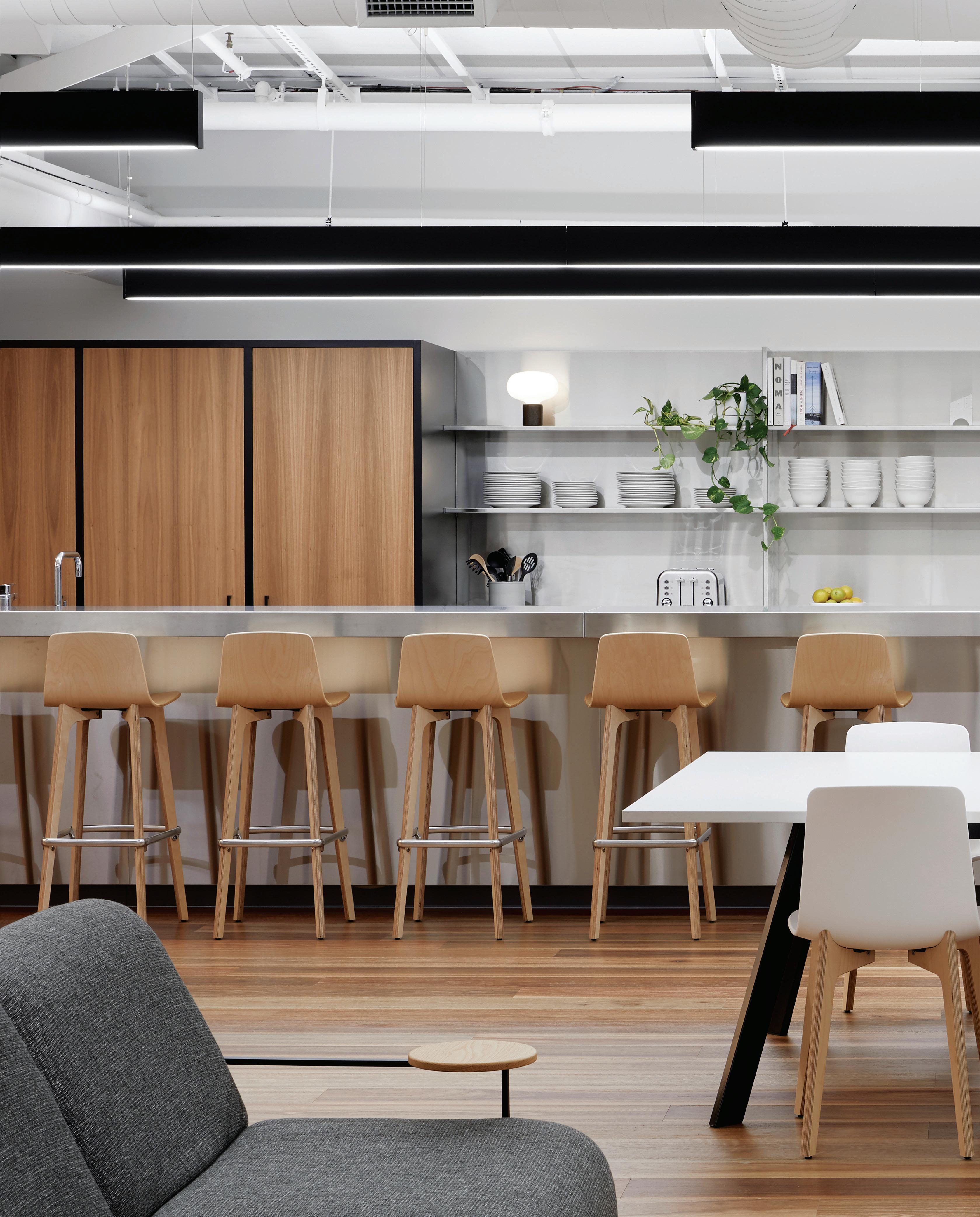
Foolscap Studio has developed a palette for the kitchen zone which references the machined stainless steel materiality found on aircraft galleys and refreshment trolleys.


individuals through wellbeing tools such as light quality, connection to greenery, and increased human connectivity; there’s also those more visceral elements of materiality, colour and form which contribute to feeling rewarded, engaged and valued within a space.
But the journey wasn’t a direct route to destination, so to speak.
“Looking at the base building plans, it wasn’t immediately clear what the function of that space was intended to be,” says Harper. The cavernous space was without windows and lacked a direct line-ofsight outside the building. As a result, “there needed to be a degree of visual variation in the space. We wanted people to have a variety of things in their line-of-sight – light, fellow team members, senior staff, and meetings rooms.”
Movement emerged as a key interior concept, speaking to the fact that each staff member is constantly on-the-go. Thanks to the site’s sweeping, 2600-square-metre footprint, the design team was able to “curve” the spatial planning to place things intuitively and offer “sinuous, skewed” lines and pathways to various destination points.
With desking lining the outer edges of the floorplate, the central floorspace is dedicated to “hubs”. Harper with design director, Adèle Winteridge, proposed a series of light canopies to hover above: a visual beacon and zoning device to pull team members into the centre of the space where they could meet, ‘break bread’, and socialise.
Bringing those tenets of wellbeing into the interior is a light well punctured through the ceiling to sit directly above the reception area. Verdant greenery complements a shifting colour palette of tones that feels quite biophilic in nature. “That gradient of colour
gives a very visual sense of movement throughout the space,” notes Harper. It also subtly defines working “neighbourhoods” in what is a gentle distinction of space.
Part of the magic of Foolscap Studio’s interior work lies in its holistic approach to design, which sees the studio develop much of its own furniture in fit-outs. Melbourne Airport Headquarters is no exception, with the team working closely with the client and bespoke furniture producer, Manapan (notable for its work with skilled Indigenous Australian makers), to produce key furniture pieces – including a boardroom table and sideboard – for the executive suite.
The hubs, too, are custom designed and hand-built to achieve that “sinuous form” and “liquid line” central to Foolscap Studio’s movement concept. Other features include the bluestone reception counter – a nod to Melbourne’s historical stone of choice.

In undertaking the project Foolscap Studio has been able to put some of its workplace thinking into action. “There’s this idea of nomadism,” says Winteridge. “We’re becoming nomads again, and the workplace is changing to accommodate that. It is also an extension of our living environments, too.” The ultimate intention here, was that the Melbourne Airport Headquarters would no longer operate under the stigma of simply being an ‘office’, but rather an alluring ‘destination’, humanised, community-oriented and responsive to its inhabitants.
foolscap.com.au
In this thoughtfully executed executive office, clear lines of site connect the CEO to the general workspace and the airside concourse beyond.





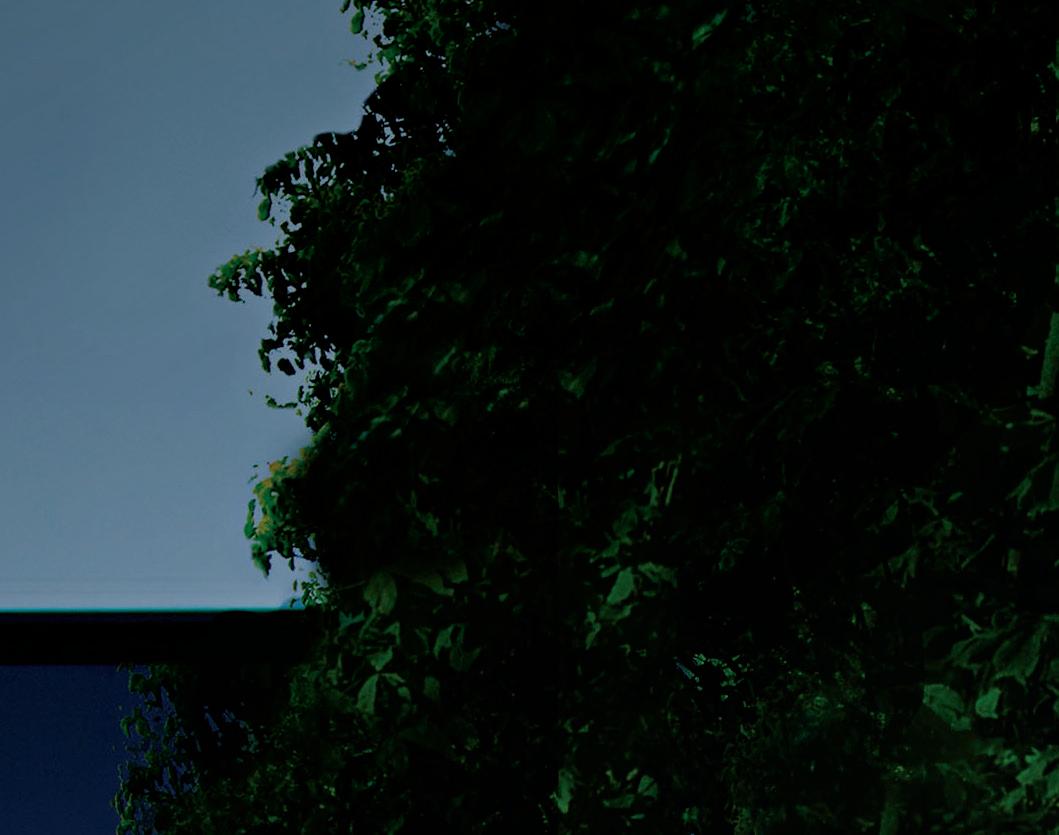







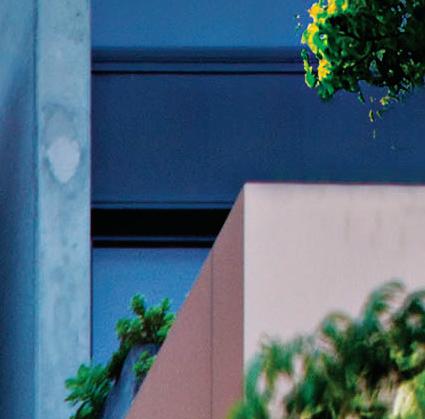


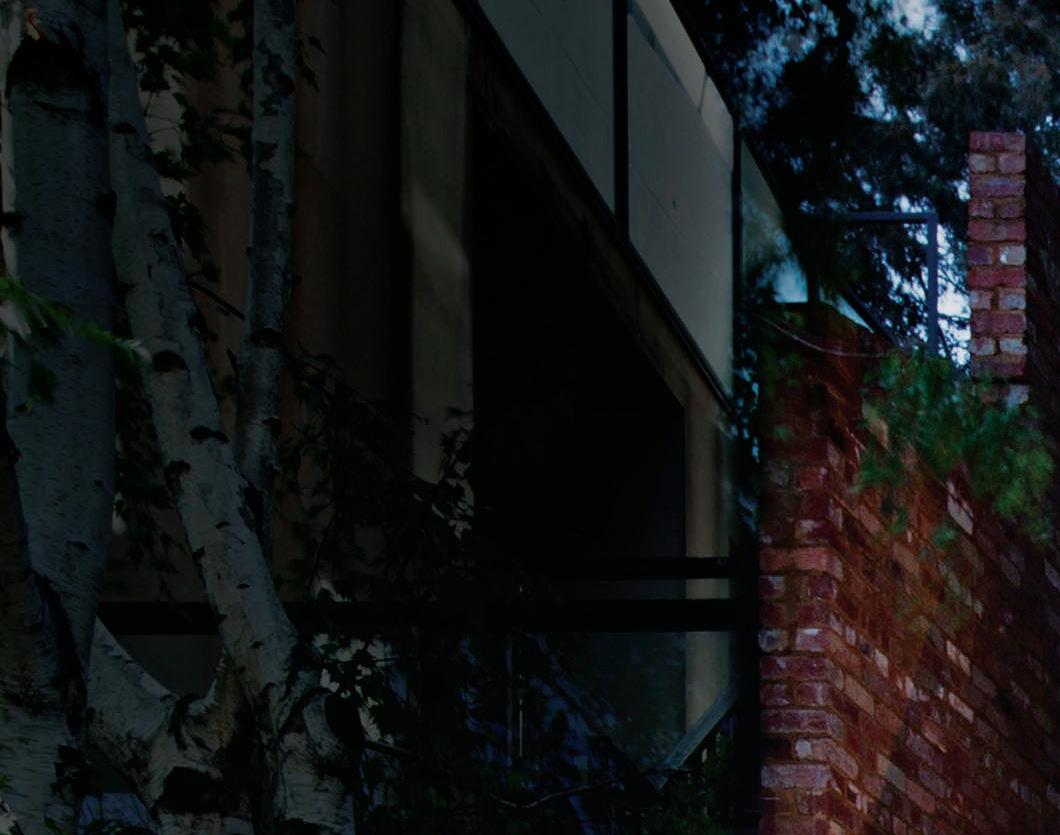




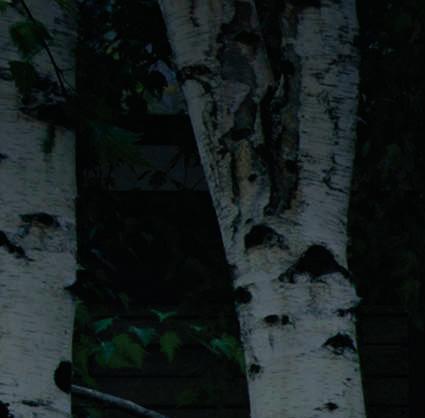





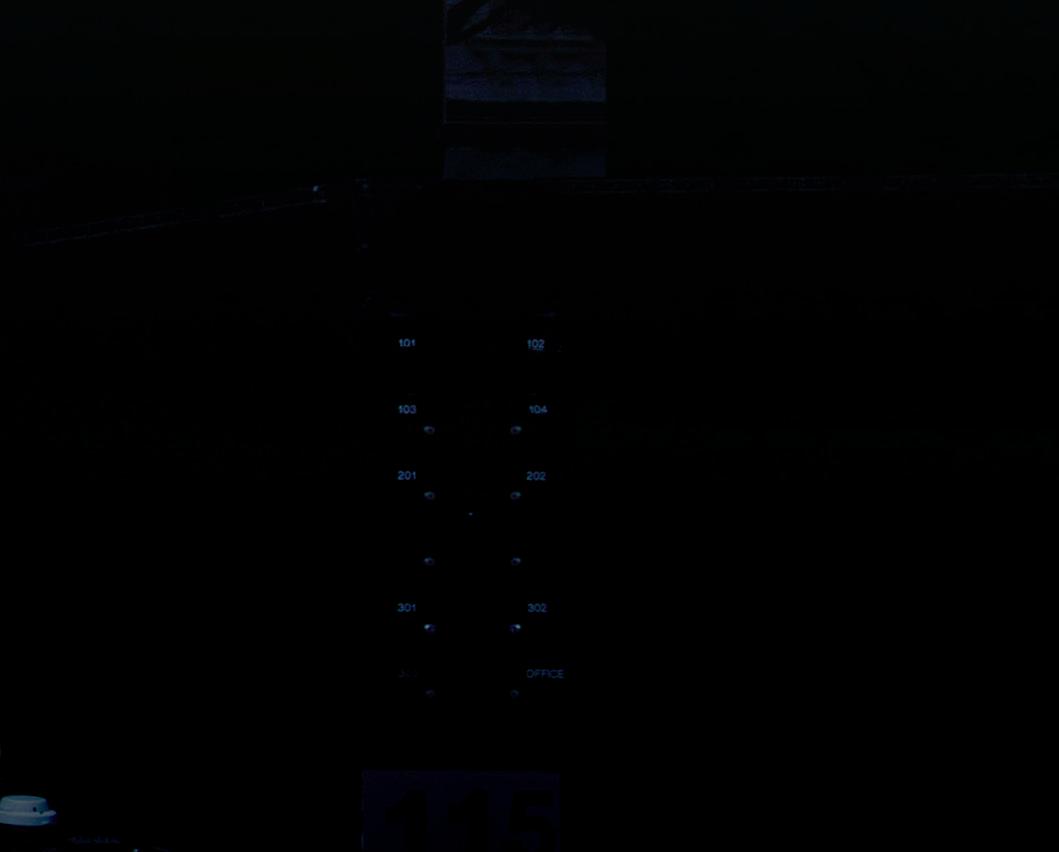












What is the true meaning of a healthy work-life balance? Vitale Design rewrites the formula with a warm and inviting coastal residence office.
“We felt passionate about delivering something that spoke of openness, where people would feel uninhibited within the space,” says Modus’ Brad Berryman.
“There’s an innate comfort and ease about being by the water – we wanted to channel and develop that through a unique culture in the workplace for a place like Cronulla.”
A charming building of historical heritage sits in the heart of Cronulla – a suburb nestled within the beaches of Sydney’s south. The Banc building redefines the meaning of coastal luxury in a contemporary hub, blending myriad residential, hospitality and commercial suites. It is on the second floor that a new-age type of workplace sits, setting the new standard for the forward-looking concept of a healthy work-life balance. Run by passionate directors Brad Berryman and Troy Mayne, Modus Projects is a facilities management company that prides itself on quality workmanship, innovation and trusted service.
There is always strength in learning from the past to create something new. The incoming wave of the next-generation workers with evolved work-life values has firmly put the emphasis on environments that look and feel bold and doubly operate as work-life centres. On the heels of this paradigm shift, Sydney-based design group, Vitale Design, was briefed to create a headquarters that did not look or feel like the standard office. “Together with the directors we explored the idea of ‘the office’ taking the form of a coastal residence. There’s an innate comfort and ease about being by the water – we wanted to channel and develop that through a unique culture in the workplace for a place like Cronulla,” says Vitale Design director, Ben Vitale.
The new site at Banc provided an opportunity to bring that seachange to Modus’ working culture. The previous office site evoked a different atmosphere – a rigid and formulaic space that was outdated and rigid to the changing nature of the Modus family. As a means for growth and evolving with the company’s changing demographic, the new office grew to become the destination that tied in the loose ends of work-life and everyday life: a ‘residence workplace’ that elevates employees’ daily work structure.
“The office needed to be an inviting atmosphere that broke down the stereotype of what a workplace is. We wanted a light-filled space without the corporate look. We felt passionate about delivering something that spoke of ‘openness’, where people would feel uninhibited [within] the space,” says Berryman. This prompted Vitale and the team to completely strip out the stigma of the interior fabric within a conventional corporate workplace. They looked to provide a space that interwove the lifestyle and culture unique to the Sydney seaside into a productive sanctuary crafted for work and respite.
At the heart of the office is the kitchen and dining table. Much like that of a home, the central gathering space offers a space to connect, converse and revitalise. The kitchen island is a platform for internal interaction and culture growth, giving a sense of belonging within
the space. The original Art Deco style of the Banc building features organic curves, heightened archways and ceilings – lending itself to a sophisticated softness to distinguish different zones and guide the individual through the office. The workstations and meeting spaces are divided into spaces akin to a home, with a main living room in the foyer, the dining room as the formal meeting space, personalised desks as your study, and the private master suites for the directors’ office. Thoughtful additions such as the filled pantry, striking art, a stocked beverage fridge, the outdoor gathering space, showers and round-theclock accessibility service different modes of working, amplifying the intrinsic values of an inspiring home.
Drawing from the jewelled tones of the water and its coastal bliss, the colour and textural concept resonated with an idyllic home of familiarity, comfort and warmth. The end result is a material palette consisting of myriad hues of deep blue and grey, delicate textures of neutral-toned linen fabrics, and natural rich timbers curated from local makers. Hints of subtle opulence are seen through the embellishment of brass trimmings aligning the edges of the office, Carrera marble from Artedomus and Gitani Stone, and sculptural lighting elements from Living Edge – to name a few. It was crucial to both Modus and Vitale Design that the heritage elements were celebrated, as well as bringing a new personality to the forefront of the design.
“There’s a juxtaposition between the darker shades within the office against the quintessential coastal colours of white, neutrals and light-toned designs paired with light weatherboards throughout the beachside suburb. Within Cronulla, the older and weathered structures are omnipresent and all follow the same design aesthetic. We came here to change the pace through a different coastal narrative: an oasis for both work and relaxation within an emerging, vibrant area with a notably agile lifestyle,” says Vitale.
According to Berryman, the Modus Head Office is the starting point for a distinct workplace resolving the present problems of contemporary office environments. It looks to integrate the reality of everyday life into an aspirational working model that simply ‘works’. “Even with the changing nature of office environments married with the mobile, fastpaced and remote culture of the modern working community, there is still a need for a space that people go to for work. This is what we’re trying to achieve here at Modus – a collaborative residence for like-minded people to come together and enjoy what they do every single day,” he says.
vitaledesign.com.au


“Together with the directors we explored the idea of ‘the office’ taking the form of a coastal residence.” Ben Vitale


Four villages, two towers, multiple connecting stairs and an entirely new working model that’s been four years in the making. How did Bates Smart combat a “long runway” to future proof its design for Australian Unity?
A lot can happen in four years. For Bates Smart’s Australian Unity project that period focused towards instilling change and executing a new workplace that would respond to the evolving needs of a large corporation. As one of Australia’s oldest insurance companies, taking time to build its new office the right way, and not rushing the process, came all too naturally for Australian Unity. But given the project’s scale, the design required thoughtful consideration for how the business may continue to adapt.
The base build was designed by John Wardle Architects and features a single tower that swallows two existing heritage buildings – The Elms Family Hotel and The Church of England Mission Hall, which happened to be designed by Bates Smart (then Bates, Peebles and Smart) in 1894. Australian Unity’s new headquarters is now home to 1000 staff members comprising 12,500-square-metres of workspace – a job the project team tackled by bringing timeless aesthetics together with a rigorous approach.
Aesthetically, a classic interior palette of timbers, tan leathers and soft greys complement the Australia Unity identity. “Part of our process was getting an understanding of Australian Unity and what they do, which always came back to wellbeing. So we looked at ways to bring concepts of wellness into the interior, in particular, the use of natural light and a softer colour palette,” says Bates Smart associate director and design lead, Grant Filipoff.
Given the volume of workable floor space, the Bates Smart team had to strategically divide it up. The lower levels house semi-private client spaces, meeting and training rooms, a theatre, a café, and a conference space that can house 150 guests. Sandwiched in the middle are levels six to 14, making up the core layers of varying work zones. And level 15 offers private spaces for human resources, finance and the executive suite. The overarching vertical levels are complemented by a more intimate verticality, coined ‘villages’, alongside horizontal zoning, or ‘neighbourhoods’.

The verticality of Australian Unity’s site is made intimate through ‘villages’. These remain interconnected by a central stair and void, with the middle layer hosting a larger social and kitchen space, to further entice interaction.


The villages break down nine levels of work floors into three sets of three, encouraging a more cohesive team environment. Encompassed within each village is a series of neighbourhoods, these human-scaled areas are sized for 25 people and consist of collaborative, touchdown and breakout areas. Finding the equilibrium of neighbourhood size came through extensive research and study: “Australian Unity wanted connectivity and interaction. To achieve this we did a number of studies and worked out details like where to position the core and how many workstations and meeting rooms per group,” says Filipoff. The design thinking that went into the voids and interconnected floors was to bust silos and allow for fluid collaboration, an oft-cited reason for open-plan spaces, but one that has been successfully expressed through the village and neighbourhood methodology.
As with any large-scale project, spatial planning was paramount. The Bates Smart team worked outwards from the core, which is positioned on the edge of the Elms building. The spatial flow follows the natural rhythm of how a typical day unfolds: “You come in, you get your locker, you get your cup of coffee and then you go to your desk”. Filipoff explains that this radiating progression of activity also “goes from noisy to quiet as the end-user reaches the periphery of the floor plate”. Workstations and open-plan arrangements take advantage of the building’s glass facade and northern views on the
edge of the city. Offices and small meeting areas are pushed back and centralised with the noisier activities and breakout zones, thus creating a sense of egalitarianism.
The change management piece on this project required a robust strategy to ensure staff buy-in. Given the “long runway” it was handled in various ways from both the design team and the client. Australian Unity worked with a slew of change managers over the life of the project, each brought in for different elements.
Alongside that, Filipoff shares that the client also instigated a “strong champion program, bringing the early adopters of the business along for the journey”. This involved having employees embed the process of packing up each day and get used to using a locker – a core feature of any agile workplace. While for Bates Smart, it was all about getting people used to the idea of the more humanscaled villages. “It’s quite a different space from where they’ve come from,” adds Filipoff.
Australian Unity’s new headquarters is fluid and adaptable, yet timeless in its appeal – a dichotomy that perfectly encapsulates a company that has stood the test time while constantly evolving.
batessmart.com


 Words Tess Ritchie Photography Courtesy of Frederick Jones
Words Tess Ritchie Photography Courtesy of Frederick Jones
Agile working and sustainability have become markers of the modern workplace. It is increasingly agreed that collaboration; multiple ways of working; self-organisation and accountability is key. Workplaces should be sustainable – both in terms of environmental impact and longevity.
It should come as no surprise really that architects are leading the way – called on to prompt these ways of working through design. COX Architecture’s Brisbane studio is a real lesson in both agile workplaces and sustainable design. Rather than adopting these values to modernise, COX is a rmly contemporary, design-focused practice whose dual drivers are “ uidity and collaboration”; the refurbishment simply took the studio’s lead. As Director, Brooke Lloyd, says, “The foremost challenge was to design a space to suit both the way we work now and how we want to work in the future.”
As such, they took a democratic and open approach to planning and designed a studio that is open, has various spaces to work in, and o ers a sense of cohesion and equity throughout. Ensuring the entire o ce has uninterrupted views to the Botanical gardens and Brisbane River, for example, highlights the studio’s lateral style. They wanted everyone to be able to celebrate the studio’s fortunate proximity.
COX’s “by the many, for the many” approach to design sees a clear expression here too – where a joinery spine extends the length of the studio and serves as the design review space. It connects “the practice through a collaborative and transparent approach to the creative process, inviting all to participate”. Bordering this area is an array of co-working and break-out settings, including a Virtual Reality space, team tables and a model making workshop, o ering sta various spaces to dip in and out of as they need to.
The kitchen – which by nature is social – is open, serving as both as an informal gathering space for sta and as a welcome space for clients. Equipped with a seven-metre long dining table, it encourages sta and clients to engage in a relaxed way – more like they would at home. While details, like a Zip HydroTap Arc in matte black, which provides instant ltered boiling, chilled and sparkling water, help facilitate an overall more agile environment.
Adjacent to the kitchen is the boardroom, unlike traditional workplaces, the space is not closed o but rather connected by a series of large, glazed pivot doors, creating a ‘Town Hall’ for events and sta meetings without isolating them from the main studio.

Another major aspect of the refurbishment is that it celebrates its heritage: the original Old Mineral House and the city’s industrial history. This speaks to studio’s wider philosophies about society, community, buildings, space and materials, as well as bene ts the project from an environmental perspective by lessening the need for ‘new’ materials and therefore energy.
Stripping back various layers of partitions, carpets, paint and false ceilings from decades of “piecemeal conversions” has uncovered various original elements – an original timber sh-bone structure, a series of cast iron columns, a patina of colour and texture. The decidedly modern palette – black timber with steel and brass detailing – also draws on the building’s origins, together letting the building’s heritage “be the hero”.
Overall, it’s a design that, as Lloyd says, “elevates both the functional performance and the brand experience of the workspace” – while also providing for the future needs of the practise. And if this is based on COX’s ethos, then the learning, surely, is that agile, sustainable workplaces need to be rooted in genuine collaboration, being adaptable, breaking down traditional notions of hierarchy and future-thinking.


Words Graham Lauren

Illustration Michelle Byrnes







As more of the people who gave the world of work its current shape retire, new notions of work, the tools it uses and where it will be done will transform the workplace to create a new economy of smarter businesses. This will make an entirely new breed of workplace entrepreneurs richer. But, with the future of work increasingly in the hands of those who have never known a life without the internet, it will likely also deepen and enrich the role of the designer.
In this economy, organisations are no longer ‘space users’ but ‘learning machines’, constantly transformed by the acquisition and development of new knowledge, driven by networked technology. And one important lesson for workplace architects and designers may be that clients don’t buy interiors or architecture. Instead they seek out leaner, more compact, agile and faster-learning versions of the businesses they already run.
Designing for such businesses necessitates consideration of new briefing inputs. This will include the fit of the workplace to the personal, articulated experiences and insights of those it must house. Its thinking must focus not only on the space it occupies, but the constant redesign of the evolving organisation itself.
Increasingly, these learning machines will adapt in rhythm with what is changing outside, and the knowledge they must contain and develop. In this and its planning lies the true birth of the discipline of workplace strategy.
Those commercial property owners able to reconceive their future business as being not just in leasing space, but in helping their customers do better business, will profit handsomely. They will also shift forever the business model terrain on which the commercial workplace will be fought.
The resource to accelerate human workplace creativity and productivity to help them do this is already right in front of, and within, us. It is in the mastery of the internet’s collaborative workplace technologies that the workplace’s entire foreseeable future lies.
And, location aside, like all others connected by the internet, workplace is being driven to become an information business. Once, from its technologies, we can derive a knowledge profile of every workplace and work community, its productivity can be read. And when its human inputs can be understood, they can also be altered to produce new results.
Across every business now exists pervasive ‘internet social literacy’, the most powerful and most unanticipated naturally emerging management tool ever discovered. Previously it was hard, if not impossible, to capture and transform into usable information the
“The focus of the modern workplace lies in data about knowledge and accommodation, not fixed square metres of property,” writes Graham Lauren. And, with the future of work in the ever-scrolling hands of the digitally-empowered, the designer’s role diversifies.
knowledge and insights of those across an organisation. Yet, as our use of and familiarity with using the social internet grows, we have reached an age of unprecedented opportunity in making the best use of intelligence across the web-age business.
In the wake of Facebook, everybody now knows how to use social media to write online, upload and share material, and make comments about those items uploaded by others. And when such communications are in writing, they can be captured easily by the mirroring, private, Facebook-like technologies now available within every business.
Workplace knowledge, insight and learning that was once out of reach is no longer beyond our grasp.
Through it, management can now tap into diverse perspectives and intelligence that was previously both unknown and unreachable. Through the precise data it can drill down on, it also has access to a bottomless, renewable resource, whose creativity may be limited only by its imagination in what it asks for.
The necessary response: Knowledge factories will make their occupants smarter
Every business can cultivate deliberate, collaborative data about how it must be accommodated to perform optimally. As such, the greatest foreseeable workplace opportunity presents itself to landlords able to understand this. They will learn how to help those who occupy their spaces become smarter, more adaptable, more productive and more competitive.
In this world, it will be up to designers and architects to guide clients in configuring the many emergent dimensions of the modern workplace around the intelligence it comprises. For the landlord capable of branding, owning and operating knowledge factories that deliver this outcome, the queues will be long.
The likely response: Myopia
As long as they remain fixated on workplace property as property, not data, those qualified only to think and act as old-style landlords will be looking where the light doesn’t shine. Because the focus of the modern workplace lies in data about knowledge and accommodation, not fixed square metres of property.
Yet, in a recent interview I conducted with the managing director of one of Australia’s biggest commercial real estate agencies, he clearly articulated the breaking state of its established business model. He

confirmed that the smarter businesses got about taking space, the less they took. He also suggested this was okay, because there are more new businesses around to take up that newly vacated space.
Another ASX-listed owner confessed to knowing almost nothing about the businesses that occupied its offices. Yet, in the digital age, it is not from ‘not knowing’ its customers that the likes of Dell Computer became a USD12 billion company within 13 years of operation; or that Amazon’s Jeff Bezos became the world’s richest man – simply from running an online bookstore. Each rethought his business to bring it closer to customers.
As landlords are physically closer to their customers, this places the onus on every property owner to learn more – and faster – about its own customers, if it is to sustain a relevant, information-driven business.
If CBD office owners thought of themselves as providing services to accommodate work, rather than in leasing space, this mental shift alone could transform their businesses and make them fitter for the future.
The likelihood of any property owner being able to do this in isolation – without learning from its customers, or drawing on its tenants’ collective internet social literacy – is slender indeed.
And the opportunity for designers is to learn how to guide them in doing so.
Location might be valuable: if you want to attract the right workers, it’s still location, location, location, right?
Perhaps. But, as work is no longer location-dependent, the rules are changing.
Future successful commercial property owners may become those both better at getting closer to customers and installing their collaborative, comfortable, connected networks of, most likely, co-working, knowledge factories closer to home.
But the design skills of those able to get inside the consciousness of learning organisations – those individuals who can guide creation of facilities that stimulate new ideas and new revenues through productive collaboration – they will earn a premium.
The reason Amazon succeeds is because it understands its customers. In the emerging learning economy, it will be the cancer of ignorance that kills others.


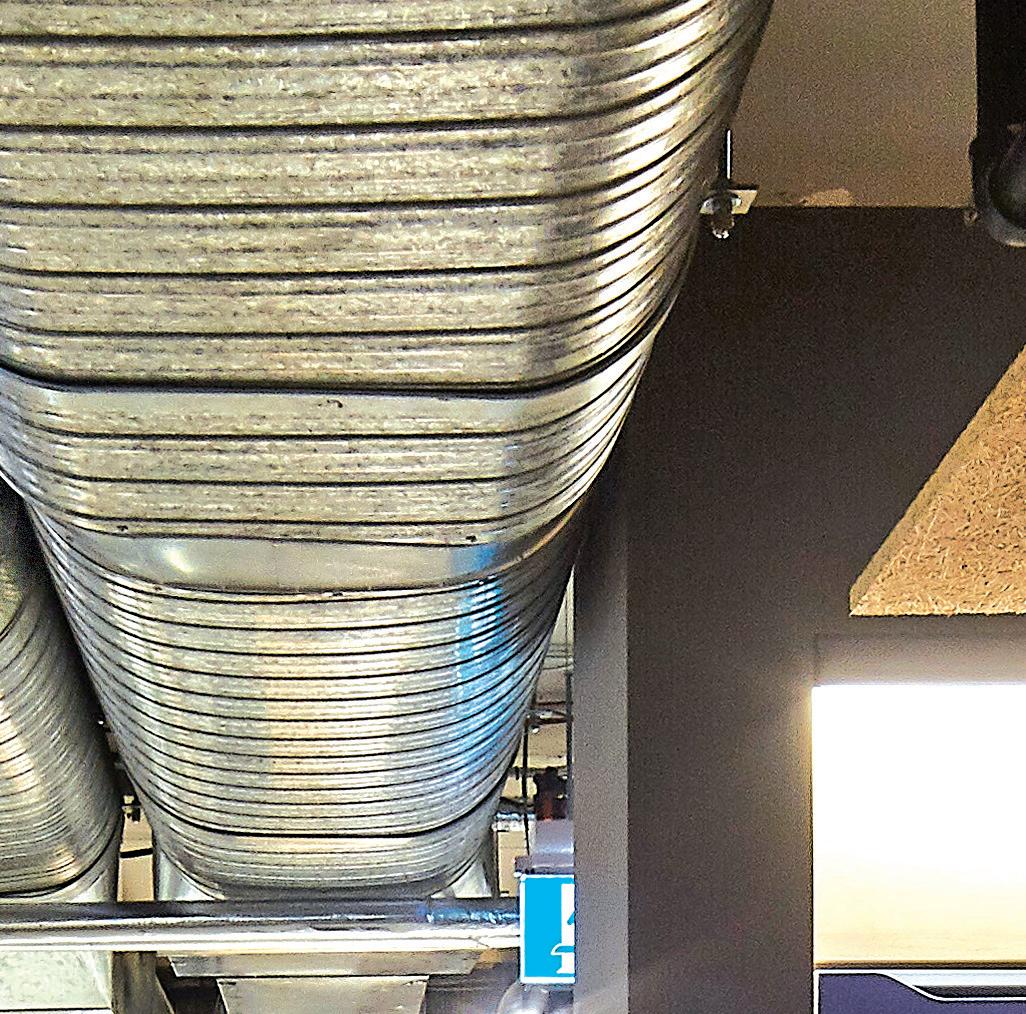



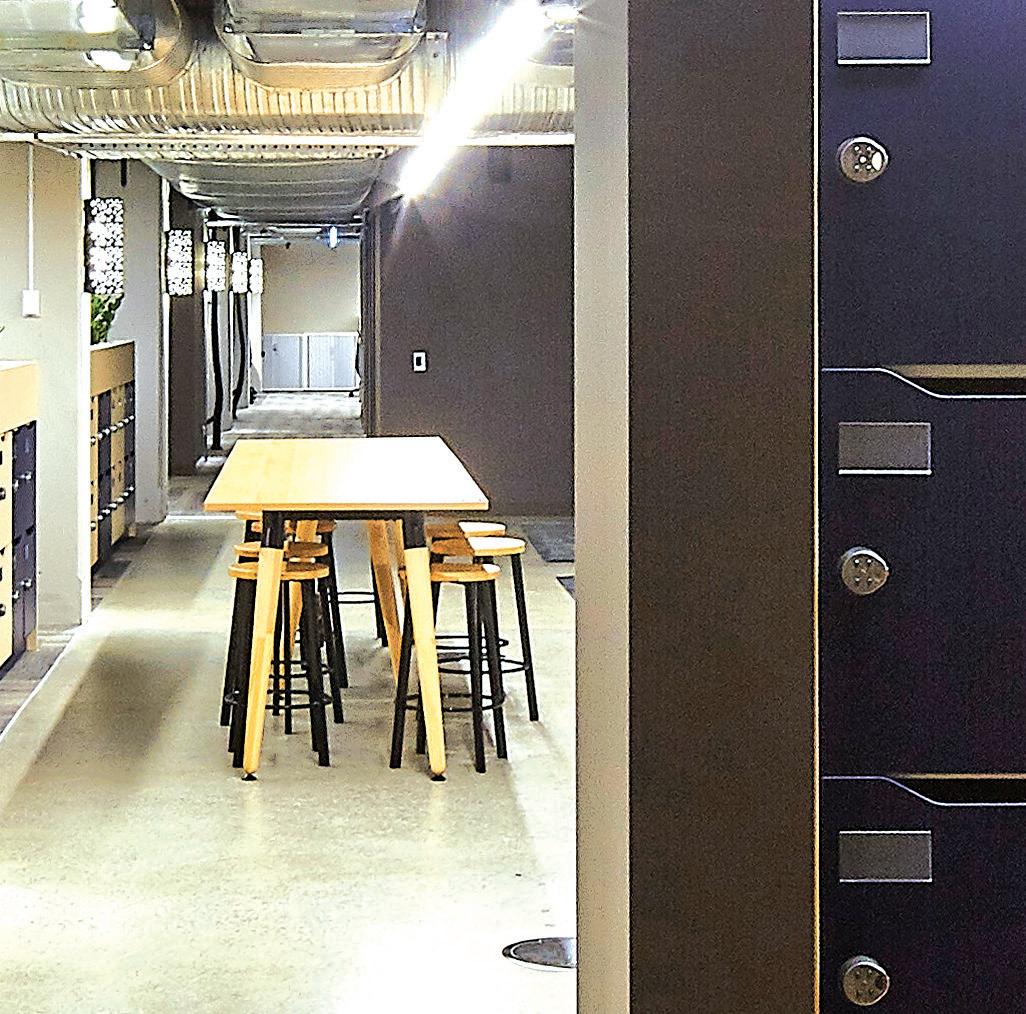

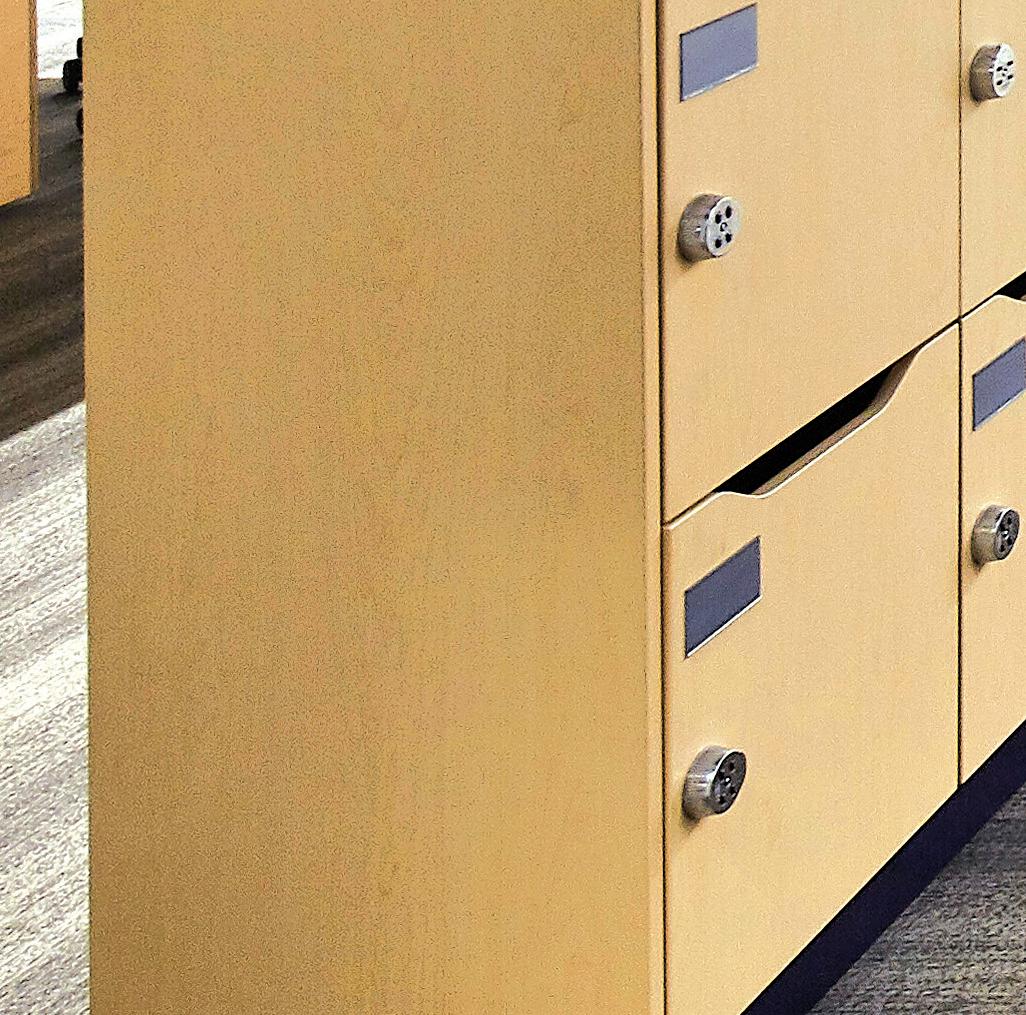







Nothing has disrupted traditional workplace design quite like the co-working phenomenon. Even as global titan and ‘workplace solutions’ provider WeWork stumbled into the New Year, the demand for office space that accommodates multiple tenants at the one time in the one place continues to grow exponentially. It’s a sign of the times that this is the way most of us want to work now. Fuelled by a changing workforce characterised by the views and ideals of Millennials and Generation Z, today’s workplaces are all about flexibility, diversity and community.
The days of single-use spaces are numbered. And according to the Gensler Research Institute’s Gensler Design Forecast (2019): Shaping the Future of Cities, integrated workplaces are the new standard. This report finds that single-use venues are being replaced by hybrid destinations, with mixed-use environments symptomatic of a broad blurring of boundaries between work and life. The corporate notion of shoehorning one tenant into an existing building doesn’t hold as much appeal as it once did and isn’t necessarily tenable in the current economic climate. Nor is it conducive to facilitating a newly desirable workplace culture based on flexibility or diversity. Could we therefore be witnessing the end of legacy attitudes around designing for an anchor tenant?
Certainly, architects and designers have shifted their workplace design agenda to embrace a more holistic point of view. As a result, outcomes better support engagement, value experience and foster productivity amongst workers. For James Grose, Sydney-based principal of BVN, this redirected focus informs the practice’s workplace portfolio, reflecting urbanity’s new crossover nature. “We once had places of doing, now we have places of being,” he states. “It’s not about silo-based activity anymore.”
Whereas the anchor tenant model promoted a sense of homogeneity, designing for a flexible workforce requires an approach not only sophisticated in concept, but nimble in aesthetic. However, it’s not without its fair share of obstacles. Making assumptions about how workers behave once inside a building and trying to create an environment that pre-empts those behaviours is a tricky proposition. As Grose explains, “The challenge is making decisions that are going to be robust enough to maintain an adaptable shell that can still shift, as it were, with the movement of each generation. So we have to create something that’s very flexible yet incredibly structured.” It’s a tactic that underscores the B:Hive co-working project in New Zealand, designed by BVN in association with Jasmax.
Are base tenants becoming a thing of the past? In the case of B:Hive in Auckland, Smales Farm looks beyond the obvious ‘office park’ to conceive a business-oriented destination for New Zealand’s mobile workforce.
Non-dependant on an anchor tenant, Smales Farm’s ambitious B:Hive concept is the antithesis of ‘office building’, housing a flexible community of more than 100 individual businesses.


Located in Auckland’s coastal suburb of Takapuna as part of the Smales Farm development, a privately-owned office park-turnedurban village, the five-level building is an impressive study in the evolution of the bespoke workplace. It caters for the area’s high proportion of small businesses and young entrepreneurs, who prioritise flexibility across all they do. From the outside, B:Hive appears as a utilitarian box with a functional, no-frills expression. This is in complete contrast to the interior, which was conceived as a soft ‘underbelly’ intended to nurture and welcome through the use of organic forms, a statement central stair and democratisation of space.
“We created a place of community with an emphasis on making people feel like they belong,” says Grose. “So the design is less about chair selection and more about an anthropometric interpretation of why people feel good in a space. And the scheme is ultimately dependent on an understanding of how humans act under certain conditions.” B:Hive comprises open areas and contained suites, all of which are re-configurable. Petitions are adaptable, meeting rooms can be easily dismantled and every piece of furniture is moveable. A business that’s growing from four to 20 people doesn’t need to relocate, it simply expands its boundaries. It also works for a big company that might occupy 10 or more floors of a building on the other side of town, but wants to rent a satellite space to operate a small-scale incubator.
The flexible layout gives rise to a variety of settings that makes each floor different to the next, allowing for a diverse range of
experiences that present as a series of custom vignettes. Each is personalised in a way that simply wouldn’t be possible in a building occupied by an anchor tenant yet there’s still a strong sense of connection between floors. This is reinforced by the stair, a curved bright orange structure that not only acts as a visual anchor, but also functions to facilitate social interaction. It sits in a void that lets in plenty of sunlight and coupled with natural ventilation and integrated acoustic arrangements makes for a very comfortable and sustainable environment.

B:Hive’s community spirit extends beyond its perimeters too, with entry to the actual workplace via a ground floor hospitality development. In this respect, the project sets a new benchmark for future workplace designs by bridging the gap between public and private realms. “This project is definitely part of the movement that’s breaking down those barriers towards the creation of shared places,” Grose explains. “And it demonstrates that a linear design process is not the way forward. There has to be a more inclusive, organic way that does include links to the broader community, because workplace design is now also about relating to urban context.” It’s a complex equation expertly simplified through B:Hive’s clearly defined interior framework, which is highly functional, dynamic and incredibly appealing to all generations who use it.
bvn.com.au, jasmax.com
indesignlive.com/collection








The IndesignLive Collection is your gateway to the best design products in the world. We put the simplicity back into commercial specification by cutting through the clutter and prequalify the best performing design products available, offering you a smarter way to specify.


How is today’s itinerant workforce shaping the mega-cities of 2030? It’s all interconnected and all begins with buildings, as Neil Christopher of Gensler points out.
Last year saw the release of the Gensler Design Forecast entitled Shaping The Future of Cities. A veritable compendium of statistical and qualitative insights, the forecast draws on global design findings gathered by the Gensler Research Institute via the firm’s impressive cache of project work. As the world’s largest architecture and design firm (yes, it’s true!), Gensler sees itself as being in a unique position to positively and consciously affect the future of our cities by “taking on the toughest challenges”. The topic of workplace is very much at the forefront of Gensler’s concerns, because “how, when and where we work” is integrally tied to how our cities will look, operate and respond to humans in the future. Gensler’s Neil Christopher draws out the big picture for us with a series of insights designed to localise the globalised forecast.
Today’s workforce is motivated by projects. The new workforce wants to work for projects and opportunities rather than organisations. The average length of time an employee has in Australia with one organisation is in the order of 14 months. They are moving between organisations to find the right projects or the right opportunities to work on and develop their skills. This is interesting for tenants as the size of tenancies are shrinking because their workforce is expanding and contracting at such a fast rate.
The typology of workplaces is rapidly changing. Spaces like customer-experience environments are now being outsourced to third-party providers. The rate of change for those environments [indicates that] tenants don’t want to hold liability in their core lease. They are de-risking their own tenancies to account for the rapid rate of change. It poses a challenge for building developers because they have to start designing buildings [to focus] on the experience of people when they are not necessarily within their core tenancy. As a result we are seeing a real rise in wellness, public spaces throughout buildings, and end-of-trip facilities.
Ten years ago, we saw the advent of building ownerrun conference centres. We’re now seeing building owner-run wellness centres, spas, co-working and agile working spaces. So for a building developer, how do they pivot their business to offer an experience solution –rather than just a building solution?
Buildings have to respond to the changing dynamics of the human experience ...
... both from a public point and a worker point of view. That’s really starting to impact decisions of tenants. Tenants no longer want the building with the ‘Wall Street foyer’. It’s no longer about how much marble we put in there: it’s about how spaces welcome people and create
hybrid environments that focus on the human experience. Continuing on from this we see lobby spaces no longer relegated to a ground floor but extended over three-to-four floors. This enable cafés, co-working spaces, restaurants and even bars to be woven into the fabric of building. This comes back to the idea of curated experiences and multi-modal work that tenants are now expecting. On projects like 555 Collins Street, Melbourne (designed by Gensler and Cox Architecture), for example, it’s really about the experience of the human, the functionality and the reality of building weaving together in an experience that is holistic. And it works for the tenant, so the building owner has longevity and is flexible to the changes of demographics and the surrounding city.
We have to build resilience into our cities. As cities change, so too do buildings. It’s a really symbiotic relationship. We now have to anticipate how buildings can ‘flex’ over 20 years. At Gensler we are starting to think about our buildings as more than a single built environment. There is ‘place’ which is the physical environment; people themselves – the evolving demographic and workforce; and ‘program’ which is critical to place making.

We are seeing enormous growth (globally) in programming around digital experience. As the internet of things and artificial intelligence start to integrate with our smart buildings, we question: how do we begin interacting with technology beyond LED screens, and how does it begin changing our experience?
From services to integrated BIM models, we receive information about how people use buildings, allowing us to forecast how we deal with people, program and place.
The fascinating convergence of building technology psychology and city shaping.
Today, 4.2 billion people live in cities and in 10 years’ time there’s going to be 43 mega-cities on the planet with populations of at least 10 billion people. How do we design for them? How are autonomous vehicles and ride-share, for example, changing the way we build roads and convert existing buildings that have, say, six levels of carparking that might not be required in 15 years?
As we start learning and anticipating, and as artificial intelligence, big data and the internet of things start teaching our buildings to work differently, and those buildings help artificial intelligence to self-learn, the future becomes clearer. Feeding that back into how we are starting to create buildings based on experience, for example, is going to be really interesting.
gensler.com
Flokk is the leading manufacturer of high-quality workplace furniture in Europe, developing a growing family of brands.

All our products are designed and manufactured with a minimum environmental impact in mind, maintaining a high lifetime value. For this work we are both awarded and certified.



“I see our mission as demystifying the roles and actions that actually take place in a day, measuring this against qualities of employee and client experience...” – Melissa Marsden of COMUNiTI.
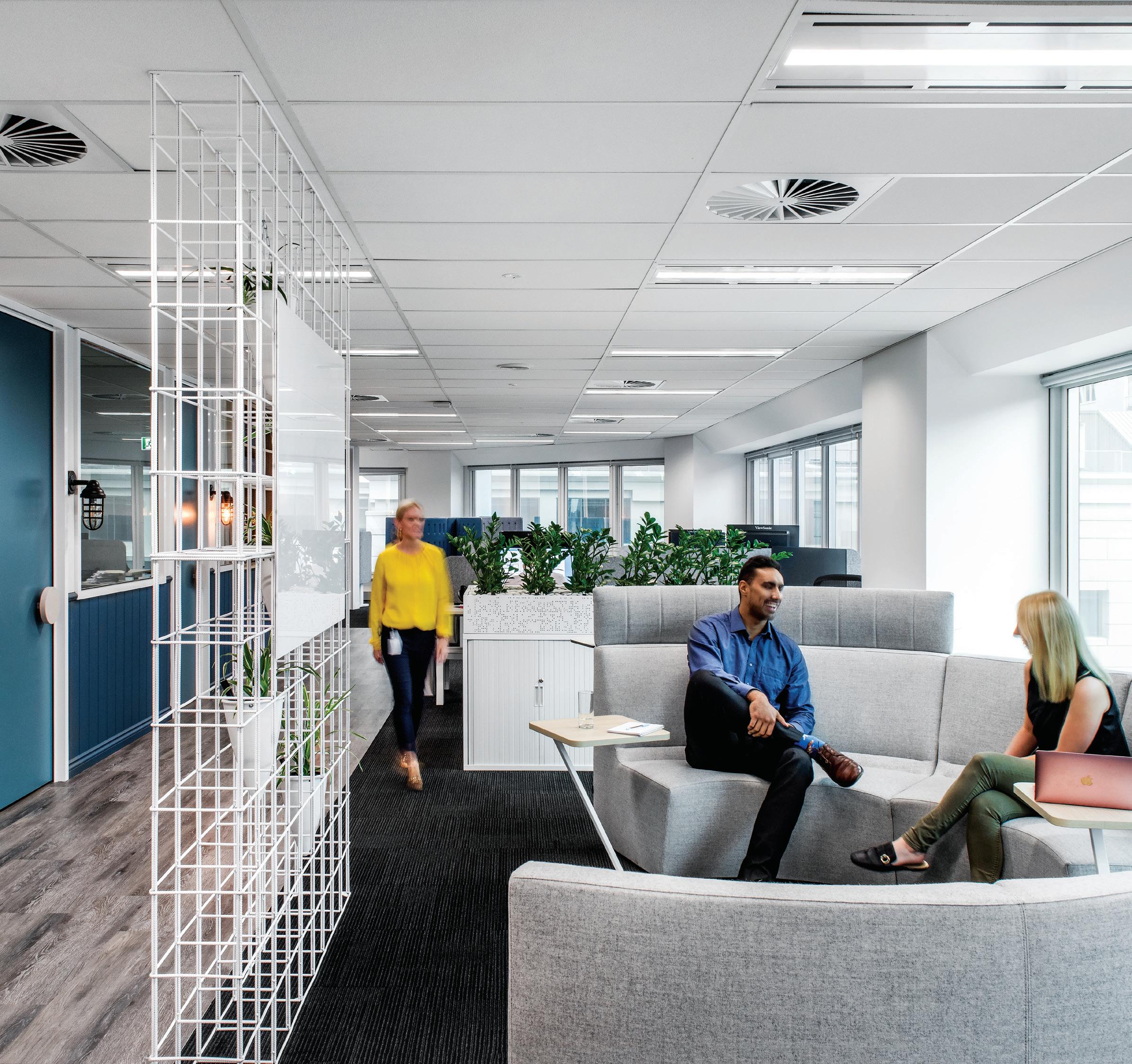
While the S&P 500 is considered by many to be the index best representing actual market performance, it appears to spend more time these days bringing out its dead. Look it up – I did this and recognised less than half of the companies listed. And of those companies I saw this morning, three out of four will topple off into the lands of receivership by or before 2030. What once was a 60-plusyear lifespan for the average outfit on the Exchange in the late 1950s, halved to below 30 years in 1980, to less than 15 years today.
How to keep up? Noticing this ever-dwindling corporate life expectancy, Professor Richard Foster of Yale University has claimed that change – the rate of transformation in the nexus of capital formation, innovation and corporate leadership – “is at a faster pace than ever”.
I suppose it’s to be expected of these hey-it’s-crazy-out-there VUCA (volatility, uncertainty, complexity and ambiguity) markets, but it certainly does look like change, itself, has changed. No longer a question of merely keeping up with the rhythm of market forces, change has transformed into the beat of business-as-usual, prompting leaders to compel disruption for their organisations before they seemingly become disrupted.
Sure, rapidly advancing capabilities, increasing transparency thanks to big data analytics, competing demands from multigenerational workforce demographics, the shockingly rapid rise of AI (artificial intelligence), and remote cloud computing have all contributed to a corporate zeitgeist of knee-jerk fretting, but for movers-and-shakers in the change management and corporate strategy space, the real question is: why do we even bother going to work anymore?
When I was asked this question by Melissa Marsden, chief creative at COMUNiTI – a strategic planning and design studio operating from Queensland – I wrongly assumed it was rhetorical. “I know it sounds a bit crazy, but I think it’s an important question to consider,” she continues. “After all, if we just look at the impact technology has made to our everyday, it has challenged not only how but why we go to work. If we can feasibly work anywhere at anytime, why do so many of us wake up every day at a specific time and go to an office? The answer to ‘why’, of course, is people.
“What we are seeing more and more is a genuine understanding that social interaction lies at the heart of workplace culture,” says Marsden. It’s all about unpacking both the rationale (the business principle) and the allure (the human imagination) of ‘going to work’. “In our work with clients, consulting on the design strategy of their workplace,” says Marsden, “I see our mission as demystifying the roles and actions that actually take place in a day, measuring this against qualities of employee and client experience, and then unpacking the spaces that facilitate or confuse these.”
Of course, today, we encounter these spaces at the historically unprecedented moment of ‘come on, everybody in!’, as yet another generation squeezes into what already feels like an overcrowded chaos of competing values, communication styles, work habits and expectations.
“In my personal experience, it’s not uncommon that I enter a client’s workplace and notice up to five different generations distributed across the organisation’s workforce,” says Nathan Sri, principal of strategy at Unispace. “But it is possible to overemphasise the perceived difficulties of the inter-generational workplace over other equally important aspects of work.
“Obviously, the changing workplace dynamics through the rise of the inter-generational workforce are central to the actual design of workplace change programs,” he continues. “But in our experience at Unispace throughout the region, it is very clear that successful change management really has a focus on the neurological dimensions of this change. It’s all about behaviours –and we need to ask a double-sided question of these in order to help change them: how do these behaviours operate and how do they form as habit?”
It’s a commonplace misunderstanding that habit formation can take the space of years to achieve, but evidence is beginning to prove otherwise. Significantly ingrained habits – what Phillippa Lally in the European Journal of Social Psychology (July, 2009) has termed “the asymptote of automaticity” – can take as little as 18 days to establish. These findings present change programs with an opportunity-rich appreciation of the power of behaviour, rather than merely the challenge it can present.
Change is the one area of work where experts violently agree: It needs to happen. While employees exclaim, ‘Again?!’ So what’s the human story behind the hype for agile, café seating and induction manuals?
“This is precisely why I spend so much time at the inception of a change program conducting a full employee survey,” says Marsden. From C-suite to the most junior recruit, the aggregation of these insights “form a personality for the organisation, demonstrating how the internal culture of an organisation can differ from its espoused corporate values”.
A recent change program helmed by COMUNiTI for human resources, industrial relations and organisational psychology practice, Mapien, in Brisbane, demonstrates the degree of positive impact such immersive behaviour-focused change programs can bring. “For Mapien, the keyword was ‘family’,” Marsden remarks. “Spatial utilisation was highly evident as teams were segregated across the floor with little to no areas to collaborate. Plus, a new merger was on the cards.
“With each team member occupying an individual office around the floorplate perimeter, internal office spaces quickly became secondary, lightless and unoccupied. Chance encounters were rare – and so, for an organisation that truly understood how important genuine team camaraderie was for its own clients, there was a high degree of awareness that evolving to newer, more agile styles of working would encourage teams to meet their full potential.”
Mapien’s change journey from a traditional workplace environment to a truly agile hub saw the coalescence of various aspects of the organisation’s business activity. This included diverse interior architecture and an appreciation for the equity that all team members played in shaping the Mapien employee and client experience. And it bore significantly dramatic results.
According to Mapien executive director, Nadia Taylor, “For the first six months after we moved into our new premises we had the highest performance on record in our 35 years in business. We attribute that to the way the newly-designed workspace enabled
our different teams to engage and come up with multidisciplinary enhanced solutions for our clients.”
Both Marsden and Sri agree that the shocking data from McKinsey & Co suggesting approximately 70 per cent of change programs fail, indicates that change initiatives need to be implemented more sensitively.
“We are cognisant that the rate and form of change we drive,” says Sri, “has to be balanced with the rate of change that not only the organisation but also its broader industry, can move with. Regression, impediments and frustrations to the change process arise from change programs being disassociated with broader business programs and imbalanced emphasis placed on certain workforce demographics – whether these be hierarchical, generational, departmental, and so on.”
Clearly reflecting the more human-centred values of our current design moment, in the case of significantly inter-generational workplaces – or indeed, any workplace with whatever degree and type of diversity – only multifaceted approaches are going to work. “Unwiring old habits in a bid to establish new ones needs to occur on a more individual scale, and well and truly before moving into the new workplace.”
Sri reminds me, here, of the World Health Organisation’s recognition of “change fatigue” in the broader workplace burnout complex. Now included in the eleventh revision of the International Classification of Diseases, the syndrome’s increasing prevalence might go a long way to explaining the S&P 500’s corporate death vortex. Change isn’t a survival tactic, it’s simply just the future.
Tell your #workwife.
comuniti.com.au, unispace.com
“Unwiring old habits in a bid to establish new ones needs to occur on a more individual scale.”
“We are cognisant that the rate and form of change we drive has to be balanced with the rate of change that not only the organisation but also its broader industry, can move with.” – Nathan Sri of Unispace.


We know that Millennials will make up 75 per cent of the workforce by 2025. By adopting a little ‘hotel thinking’ we begin to understand what drives them.
Words Rosie Morley with contributions by Dan Cox
We are currently seeing the rapid emergence of highly experiential interiors. Across hotels and co-working spaces, a plethora of hybridised environments are appearing faster than ever before. As a result, the public realm is increasingly driven by a need for the kind of connection these spaces are fostering. The deeply human need to be part of something bigger can align with the provision of a universal language to connect through the spaces we inhabit.
Hotel experience has shared parameters with workplace design. These are highly curated spaces that have cast a powerful spell upon the workplace sector. We see more briefs calling for a greater sense of alignment with next-gen lifestyles, with many of the sited benchmarks increasingly turning to the world of hotels. Leveraging from other sectors is no new trick, yet there is a particular synergy found directly between hospitality and workplace design.
When embarking upon designing a hotel, before looking at spatial logistics, our process is to map out the guest’s journey, from arrival to departure. We want to know what the guest will experience as they take their first steps out of the taxi, what they see upon entering the lobby, what they sense and feel as they enter their room. How do we explore, capture and unpack the intangible elements of design? The operational brief tells us what the experiential story should be; we distil this into a feeling, a sense of the place we are looking to create, and work through our methodology to translate this into a physical design. We know one way this occurs is when a space interacts with the user in such a way that can access as many of the senses as possible. The more we can engage beyond the visual, we find a deeper attachment is reached with the user. We know this is inherently linked to memory and connection. The product becomes the resonance with experience rather than the space itself.
Sensory and experientially fuelled design is no longer just for galleries, exhibitions, or hospitality. We see this as a critical part of workplace design, as Millennials are constantly seeking to be delighted and surprised in their everyday interactions. We know that this generation has the greatest discretionary spend on experiential purchases than any other, therefore why doesn’t their workplace sit on par with the places they socialise, live and travel to? According to Emergent, Millennials make up 37 per cent of our current workforce, a number that will expand by almost 75 per cent by 2025. It is the
generation that all others align with the most, therefore we must recognise what drives them.
In a world of transparency and review culture, the likes of Trip Advisor for hotels is responded by Glassdoors for workplace. Nothing is sacred and the idea that everything is trackable and rateable is a gamechanger. The high-touch, on-demand, opt-in culture is natural for these digital natives. In a world of fake news and fabricated lifestyles, it’s no wonder the Millennial is seeking authenticity and connection. In tandem with the search for realness, is the omnipresence of social media leveraging and self-brand association. Given more than half our lives are spent in the workplace, we must re-frame how this environment contributes to a sense of belonging. The workplace is therefore intrinsically central to one’s identity.

Ultimately it is about choice and freedom. Hotels offer infinite possibilities: you eat, work, play, rest, come and go as you please. It is this sense of lifestyle integration into a public environment that taps into the link between hotel and office. The concept of 24/7 for hotels also applies to the work environment, with technology enabling virtual space for focussed work and the physical office for more human interaction time. The confines of nine-to-five or Monday-to-Friday are antiquated and less fundamental to getting the job done. Therefore, work invariably becomes part of our lifestyles, hence hotel thinking becomes relevant.
With this also comes the greater necessity for re-set spaces. Hotel principals guide us, with arrival and checkin experience, circulation distances, tables that work for dining and working, lighting scenes, scent and sound scapes from day to night, etcetera. The list goes on, there is a lot to learn from hotels that can create high impact on an office environment. The touchpoints of hotel design assist with all the interstitial moments between work tasks. With agile working on the rise, the individual’s day becomes aligned with that of a hotel guest.
It seems the Millennial workforce poses a simple question: how does my daily environment make life easier? This is the underlying mantra that hotel design returns to; how to anticipate every need and generate an intuitive experience. One of choice, possibility and wonder. Both workplace and hospitality sectors are seeking the same outcome, creating places people are drawn to and ultimately want to stay within.
carr.net.au
 Rosie Morley is associate director at Carr.
Rosie Morley is associate director at Carr.

Founded by artists Hannah Plumb and James Russell, Londonbased studio JamesPlumb has spent the past decade straddling the worlds of space and sculpture. Rich yet raw, their interiors ennoble imperfection and are imprinted with narratives. Take Aēsop Lamb’s Conduit Street in London, for example. When the designers were handed the location for the store, they were drawn to the site’s connection to water. (In 1577, the street was christened with William Lamb’s name after he donated money to rebuild an underground conduit). Water – viewed by the designers as a ‘material’ to be subtly and elegantly controlled – became central to the retail environment’s concept. Another key factor became lighting, which is how Plumb and Russell met PSLab. They consulted with experts at the Beirutborn lighting company via Skype to find the perfect balance of product illumination and water reflection. “From the outset our processes and ways of working aligned,” says Plumb, “so we were delighted when they asked us to collaborate on the design of their London home.”
The project would be JamesPlumb’s largest – and first architectural – project to date. Innately artists, Russell and Plumb had developed an Aēsop store that could be mistaken for an art installation – a multisensory experience that just happens to sell products. PSLab London is also typologically ambiguous: grounded in hospitality, it is neither an office nor a showroom yet functions as both. It’s a theatrical space for PSLab to exhibit and explain light and optics to its (potential) clientele, and a workplace for its London team.
JamesPlumb is known for uncovering beauty in the everyday – and what could be more everyday than eight hours spent at the office? But by focusing on the culture of their client – “Lebanese culture is one of the warmest and most welcoming we have ever experienced,” says Russell – the studio imbued PSLab’s London home with just that: a sense of home. “Multiple visits to the mothership in Beirut, as well as their other spaces such as in Stuttgart, showed us first-hand the organic way they work. We always referred to the project as a ‘home’ – albeit a professional home – and approached the design as such.”
In this final case study, Indesign visits the ‘professional home’ of PSLab in London. Designed by JamesPlumb, this space is neither an office nor a showroom, but functions as both.
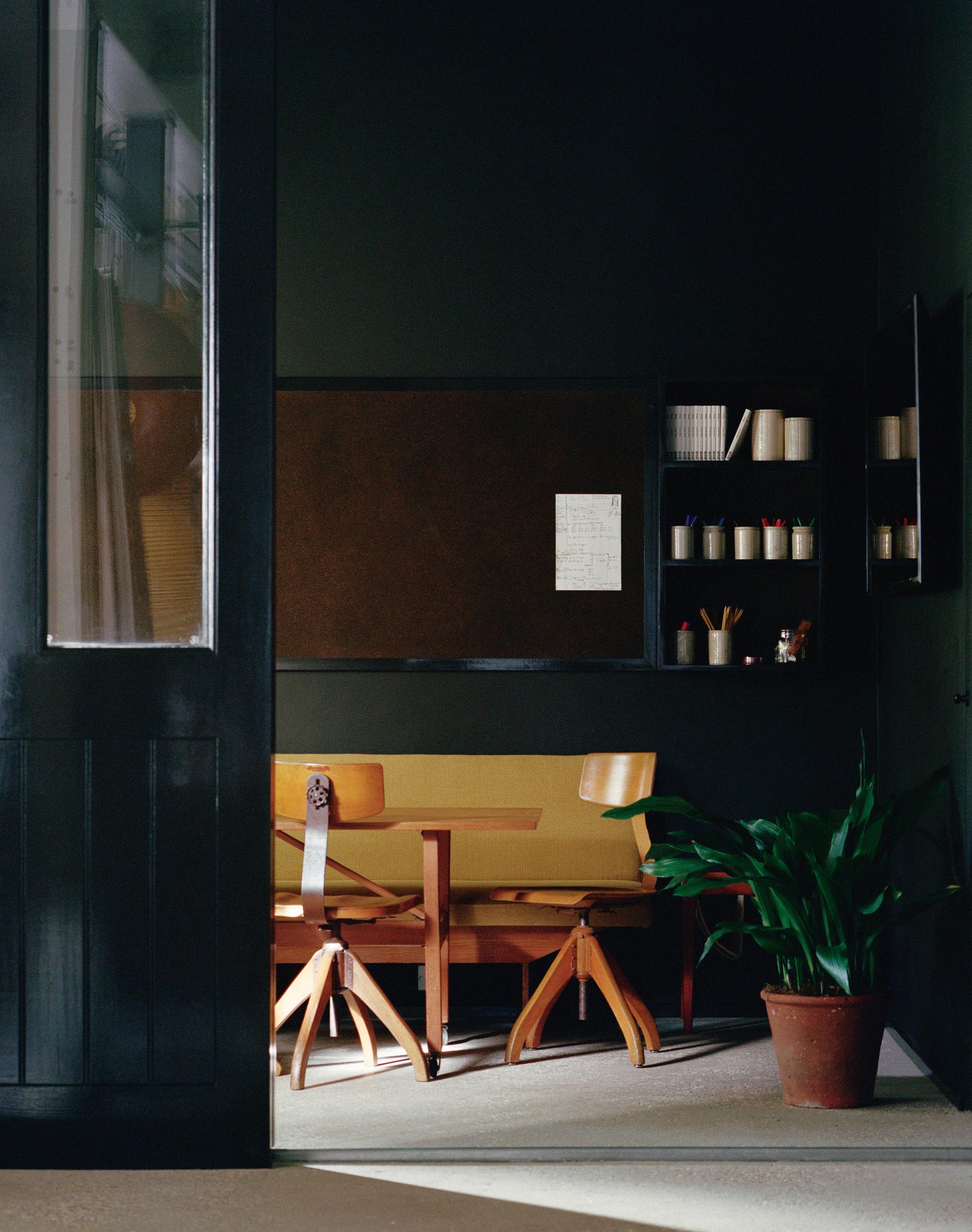
A coincidence, perhaps, but the arrival of this homely space coincides with a sharp increase in remote working. BBC reported a 74 per cent rise in the number of people working from their own residence between 2008 and 2018, and by 2020, half of the United Kingdom’s workforce is expected to be working remotely. Some of the main drivers behind the surge are flexibility and freedom: a recent survey of remote workers from the Association of Independent Professionals and the Self-Employed (IPSE) found that 55 per cent of people said increased flexibility was the greatest advantage of remote working. It’s no wonder, then, that flexibility has entered the design of fixed workplaces.
JamesPlumb’s concept, though, is not reactionary. Rather than respond to such data or look to other specific trends in workspace design – the rise of service-oriented offices, for example, or wellness-driven environments replete with relaxation pods – the duo merged their understanding of PSLab’s working culture with their own intuition.
“There is no one-size-fits-all way for how people work at their best,” says Plumb. “Everyone is different, and different roles require different atmospheres. Some people benefit from quiet and privacy to focus, others respond to interaction and connectivity – and most jobs need both at different times. Our fluid and flexible
design has defined areas, yet functions overlap and merge. Almost every surface can serve multiple uses.”

Biophilic design is also gaining importance for its contribution to physical and mental wellbeing. Into PSLab’s concrete landscape, JamesPlumb inserted permanent planters to enrich the space with greenery. “The feel-good aspect and beauty of plants is multifaceted and goes without saying, but they were also key in softening the concrete both visually, texturally and acoustically, and they allowed us to create natural screens to divide spaces without segregating them.”
In an age where it’s possible to work from almost anywhere at any time, many are considering the necessity of an office at all. But unlike co-working environments or a local café, company headquarters are the place to foster team morale. To do so, they should be places to which employees want to go, not have to go. “Put very simply,” says Russell, “it was important to create an environment that people are happy to spend time in. And that comes from a holistic approach to the design rather than specific items – otherwise they would be tokenism or gimmicks.”
jamesplumb.co.uk
At PSLab, “steps extend, becoming levels. Floor becomes bench. Plinth becomes floor. Table becomes chair. Seats within steps. Steps within seats”, says JamesPlumb.


As global consumers, the need to create experiences within our homes is only increasing. We want spaces that are immersive; that delight our senses; that are meaningful. But what does this mean in terms of design? How does it translate to products, form and function? What is the future of such dynamic environments?
Exploring the full breadth of what ‘experiential living’ means today is the KOHLER Design Forum, which will make its Australian debut in Melbourne next month. Entitled The Dimensions of Experiential Luxury, the Forum is rooted in an examination of the consumer mindset. It considers global consumers’ needs for experiences through immersive innovations and elements, and delves into the many facets that help create rich and dynamic environments.
“Experiential Luxury invites people into a place that seeks to delight all our senses, where meaningful design, technology, colour, pattern and material are inextricable,” says Erin Lilly,
KOHLER Design Studio Manager. “At its core, it is the combination of experience and expression. It’s about adding perfect detail, that nal touch that makes your space an extension of you.”
For KOHLER, this is realised through incredibly re ned products that use creativity and innovation to amplify personal experience. Its Intelligent Toilets and Digital Showering range, for example, are designed to orchestrate the ultimate personalised experience. Meanwhile KOHLER’s sophisticated array of colour, material and nishing options allow consumers the ability to set the desired tone of their space through the nest of details.
Connecting KOHLER’s passion for life-elevating design with its global design community, the KOHLER Design Forum is, at heart, about exploring the future and impact of design and providing a platform for the design and architecture industries worldwide to interrogate ideas together.
Page 76 –
Architect Wilson Architects and Henning Larsen
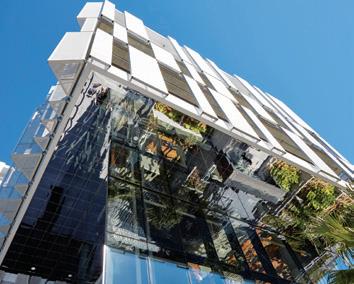
Architect and Interior Design Team, WA John Thong, Hamilton Wilson, Michael Herse, Daniel Tsang, Annie Yen, Luke Gavioli, Sophie Lorenz, Georgina Russell, Alex QuahSmith, Charlotte Bryant, Ilka Salisbury, Jenny Yang, John Harrison, Lia Kim, Maddie Zahos, Michelle Duval, Rachel Levi, HLA’s Jacob Kurek, Julian Chen
Project Manager Robin Sweasey, Cassandra Howard and Jeremiah Lynch, Turner & Townsend Thinc
Builder Hansen Yunken
Civil / Structural Engineer Opus
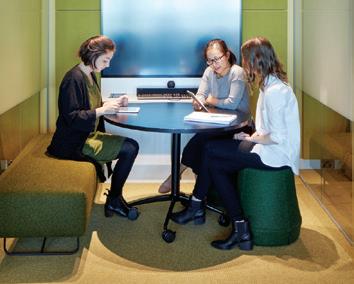
Electrical Engineer WSP
Fire Engineer ARUP
Façade Engineer Aecom
Hydraulic Engineer Opus
Budget $50 million
Final construction cost $94 million
Duration 2017-2019
Wilson Architects wilsonarchitects.com.au
Henning Larsen henninglarsen.com
Furniture Herman Miller Caper chair, Herman Miller. Okamura Runa chair, UCI . About A Chair, Bella coffee table, HAY. FS Line conference task chair, Wilkhahn Horizon ottoman, Jardan Very task chair, Haworth Derlot Editions Stump stool and Prisma seating, Living Edge . Arper Dizzie side table, Prostoria Polygon coffee table, Stylecraft . I.AM table, Debetrek
Finishes
Blackbutt timber flooring. Ege Epoca Knit Ecotrust carpet tiles, RC+D. Marmoleum Decibel acoustic flooring, Forbo. G654 Granite tiles, Parella Tiles . Acoustic panelling, Autex . Linear Batten ceiling, Expanded Mesh ceiling, Armstrong Flooring . Mirrored ceiling, Alucobond
Fixed & Fitted Carboni II inset basin, Cube bathroom range, Caroma
Your comprehensive guide to the specification schedules for our featured projects.QUT Peter Coaldrake Education Precinct Building Brisbane
Mercury
Auckland
Page 84
–
Interior Design
Warren and Mahoney
Interior Design Team
Holly Campbell (project lead), Arron O’Hagan, Sarah Hong, Scott Compton, Andrew Tu’inukuafe
Project Manager
Rebbeck Dunn Watters
Builder Alaska
Structural Engineer
MSC
Services Engineer
Agile Engineering
Acoustic Engineer
Earcon
Fire Engineer
Crossfire
Planting Supplier
GreenAir
Quantity Surveyor
Barnes Beagley Doherr
Duration 9 months
Warren and Mahoney warrenandmahoney.com
Furniture Rubix and Thinking Works
Okidoki workstations, custom focus pods, Smartalock lockers, Thinking Works U.R meeting tables, SmartSpace Vitra Softshell soft seating, Vitra Bistro café tables, Kada . Bolero café stools and chairs, Vidak . TON dinner booths, Statement ID Stork café leaners, Aspect Baker collaboration stools, IMO. Warren and Mahoney meeting booths and garden hubs, Retail Dimension
Finishes
Modulyss Nxtgen carpet, Heritage Carpets . Bolon Artisan and Botanic vinyl, The Andrews Group Ultra Oak Engineered timber flooring, Forte Flooring . Atrium stairs and grandstands, Decortech Multigroove . Cube and Vertiface acoustic wall panels, Autex . Grey Stream marble, SCE Stone . Abodo Rhombus timber wall battens, Retail Dimension
Heradesign Baffle basic feature ceiling battens, Apex Interiors . Heradesign Superfine feature ceiling tiles, Warren and Mahoney and Autex feature atrium ceiling, Apex Interiors . 3M dichroic film, Colourworx


Lighting
Luceplan lighting pendants, JSB Lighting . Zero Mist and Silo lighting pendants, Simon James Design
Fixed & Fitted
Prime Panels cabinetry, Laminex Caesarstone benchtops, Retail Dimension . Billi Quadra Plus drinking water unit, Merquip
Carpe Diem at Barangaroo Tower 2


Sydney Page 92
Interior Design
Geyer with International Towers
Interior Design Team (Geyer)

Robyn Lindsey, Roberto Rivera, Sue Solly, Angela Kuroiwa, Kim Thornton-Smith, Steve McDonald
Companionway Architect
Collins and Turner
Project Manager ST Projects
Builder Buildcorp
Structural Engineer Arup
Mechanical and Electrical Services Engineer
NDY
Hydraulic and Fire Services Engineer
Warren Smith & Partners
Lighting Llight
Landscape Designer Aspect
AV and Acoustics
Audio Systems Logic / Acoustic Logic
Sustainability
Surface Design
Certification, Compliance Philip Chun & Associates
Quantity Surveyor WT Partnership
Artwork Consultant
Barbara Dowse
Graphics and Signage The Gallery Collective
Technology Platform
ACA Projects & 42 Interactive
Duration 3 years
Geyer geyer.design
International Towers internationaltowers.com
Furniture iSateletti workstations, Alcove highback two seater seating, Softshell tub chair, Nes laptop tables, Unifor, Vitra . Herman Miller Aeron task chairs, Setu stools and meeting room chairs, Crosshatch lounge chairs, Eames bar stool, leather side table, Muuto stacked shelves, Living Edge . LEN Softscape quiet room stools, Softscape modular lounge, Arper Duna meeting room chairs and Zinta banquette, Blade table, Stylus meeting room tables, Stylecraft Moroso Mathilda social space chairs, Inclass Dunas social space stools, Moroso Diesel Longwave armchair, Vondom folding tables, Mobilia . Kila social space chair, Steelcase Hosu lounge, Carry On Stool ottoman, designFARM . Pearl swivel social space chair, Tuck coffee tables, Jardan Stand Up stool, Wilkhahn LoQit lockers, ACG Fire and Security. Planters, Posh Services
Finishes
Partitioning, Jeb. Custom built companionway stair, Arden Engineering . Natural Oak Ravine wall cladding and joinery, Euroline . Sancerre
Hand Chiselled wall tiling, Pacific Bluestone floor tiling, Eco Outdoor. Carpets and rugs throughout, RC+D
Engineered oak timber flooring, SE Timber
Artwork
Battleground, Level 31 central core artwork, Jason Wing
Containment of the Seven Seas, Level 30 central core artwork, Brian Robinson . Locker artwork, Christopher Pease
Melbourne Airport Headquarters Melbourne Page 98
Interior Design Foolscap Studio
Interior Design Team Adèle Winteridge, Rob Harper (project lead), Sri Boriharnvanakhet, Madeline Freeman, Cara Gabriel, Samuel McIntyre, Emily Minchin, Aaron Shipperlee, Franky Walker, Kathrin Wheib
Developer
Linc Horton, Melbourne Airport
Builder Buildcorp
Strategy
Relative Projects
Structural and Services Engineer
Aecom
Fire Engineer Lehr Consultants
International (Aust) Pty Ltd
Project Manager
Sara Granata, Melbourne Airport
External Project Manager Matt Shilton, TM Insight Pty Ltd
Landscape Designer Pop Plant (plant consultant) Atmosphy (installation)

Furniture Collaborator Manapan
Duration 19 months
Foolscap Studio foolscapstudio.com.au
Furniture
Featherston Scape Armchair, Ivy Coffee Table, Grazia & Co
Custom Foolscap Studiodesigned executive furniture, Manapan . Muuto Oslo 3

Seater Sofa, Herman Miller Eames Aluminium Group
Executive Chairs, Herman Miller Eames Aluminium Group Management Chair, Herman Miller Eames Moulded Plywood Chairs, Living Edge . Punt Gin modular sofa, Design Nation . Lottus wood stools and chairs, Confident 4R chairs and stackable chairs, Ke-Zu . Trace counter stool, Huggy Low Stool, Sputnik coffee table and side table, Obodo. Ronin wood leg chair, armchair with arm and castors, and bar stool, Zenith Artek E60 stool, Anibou Stork table and round table, Aspect Furniture . Sabre table, Flip-top, custom café tables, Interstudio
Lighting
Marset Theia floor lamp, AJAR . Flos Superloon, Euroluce
Fixtures
Aver Pull, T Pull Handle, LO & CO
Finishes
12mm Cube acoustic panelling, Autex . Broadloom Epoca Texture, RC+D Broadloom and tile, Tretford flooring, C4 National Flooring . Scuba and Micro upholstery, Kvadrat Maharam . Clarity 800 perforated metal, Locker Group. Fly ash ET-21, Exile Global Technologies Marmoleum, Forbo furniture linoleum, George Low Bluestone Paver, Bamstone Lignapal spotted gum veneer, George Fethers Forscolor MDF, Porta . Paints, powdercoats and laminates throughout, Dulux
Modus Head Office, Cronulla Page 106 –
Interior Design Vitale Design
Principal Architect Ben Vitale
Project Architect Belle Wang
Project Manager Modus Projects
Builder Modus
Landscape Designer Landforms, Julien Roy
Flooring Mint Flooring
Other JB Interior Fit Out
Budget
$650,000
Duration 10 months
Vitale Design vitaledesign.com.au –
Lighting Lambert & Fils Laurent 03 feature lighting, Living Edge General lighting, Just Lights
Finishes Beach life rugs, Halcyon Lake . Art, Art Bank Curtains and blinds, Simple Studio. Joinery, wall panelling, and Vitale Design boardroom table and reception desk, JB Interior Fit Out . Stones and tiles, Artedomus , Gitani Stones . Vitale Design custom door hardware, Durado Herringbone flooring, Mint Flooring
Australian Unity Melbourne Page 112 –
Interior Design Bates Smart
Interior Design Team Grant Filipoff, Claire Williamson, Richard Healy, Rachael McCarthy
Project Manager, Base Building Duo Projects
Project Manager, Fit-out APP
Builder Probuild
Structural Engineer, Base Building ARUP
Structural Engineer, Fit-out Robert Bird
Services Engineer, Base Building ARUP
Services Engineer, Fit-out NDY
Specialist Lighting, Fit-out
2B Designed
Signage
Studio Ongarato
Duration 4 years
Bates Smart batessmart.com
Furniture
Very task chair, Haworth Krossi workstation, Schiavello. Solid oak Curve custom table, Josh Carmody Arper Zinta lounge, Cross table and customised lounge, Ross Gardam custom Picnic Leg Table with built-in planter, Stylecraft . Vitra Alcove high-back threeseater custom-finished seating, Unifor. Artek 64 high stool, 60 low stool, Chair 66, Anibou . Herman Miller Eames Aluminium Group low-back seating, Eames segmented tables, Living Edge . Hay About A Chair, Cult
Finishes
Verve Oak 190, Colour Cannes, (new building), Colour Barrier (heritage building), Winspear Group Portmanteau Collection carpet tile, Interface Traverse carpet tile, Desso Custom Supaline System and Supaslat System feature timber ceilings, SUPAWOOD



Page 126
Architect and Interior Design BVN in association with Jasmax

Project Manager
Xigo
Builder
Leighs Construction
Structural Engineer BGT Structures
Services Engineer WSP
Structural Engineer BGT Structures
Mechanical Engineer eCubed
Façade Engineer Lautrec
Civil Engineer Harrison Grierson
Quantity Surveyor White Associates
Budget NZD$60 million
Duration 27 months
BVN bvn.com.au
Jasmax jasmax.com
Furniture Herman Miller furniture, Unison Workspaces
Schiavello furniture, Kada . Furniture generally throughout, Jardan, Simon James Design, Wilkhahn, Artek, Vidak / BOSS Design

Finishes
Hay finishes, Amara
Oyoy finishes, Luumo
Design . Mokum textiles, James Dunlop Textiles
RC+D flooring, Synergy
Flooring . Tarkett finishes, Jabonsen . Textiles generally throughout, Kvadrat
Maharam . Finishes generally throughout, Instyle, Artedomus, Resene, Spectrum Floors, Regupol, The Tile People, Formica / Laminex, Maximus NZ, Dimond, Autex , Portugal
Cork
Lighting
Lighting throughout, Simon James Design
Fixed & Fitted
Fixtures throughout, Astra Walker
Boiling water tap, Billi
Mapien Brisbane Page 135 –
Interior designer COMUNiTI

Project Manager COMUNiTI
Builder Focus Fitouts


Services Engineer Interior Engineering
Duration 10 weeks
COMUNiTI comuniti.com.au
Furniture Okamura Sylphy chair and Muffle workstation, Relaxhouse Kami dining and Sargood armchair, custom tables, custom desk with over-bench custom PET screen, Interchange sit-tostand workstations, Thinking Works Okidoki and I.AM tables, UCI . Tom Skeehan Hoshi armchair, Keith Melbourne Bloom circlet high-back seating and highback screen with rear bench, Helen Kontouris Softscape, Sipa Cosse table, custom BLD frame, Thinking Works Blade high table, Stylecraft David Walley Craypot, Sean Dix Factory bar stool, Zenith Kursaal lounge armchair, Lisboa table base, Design Nation . Ivan Woods Bomba Couch, Schiavello. Tide Design Tuki desk, Simon James Design Felix chair, Janie Collins Interiors . C4 4 door locker unit, bag storage, Interloc
Plyroom Shibui room divider, Clickon Furniture . S Series, Planex . Copenhagen, Architect and Piccolo collection, Freedom Home Republic Oakland seating, Adairs . GLADOM tray table, Ikea Madras Link, Pillow Talk
Finishes
Flooring – Grey Dune
Textured Wood, Interface
Eterno European Oak, Tongue N Groove
Walls – Grey Pebble Quarter, Odyssey, Grey Pebble, Tamas (door), Sailing Safari, Dulux . Easycraft EasyDado, EasyREGENCY by Easycraft
Feature wall – Easycraft
EasyREGENCY, Gunnersens
Reception – Apexcord, Azure, Baresque . Splashback –Vogue, Argento, and IN Lilla, VO33, Classic Ceramics
Skirting – Type G, Finlaysons
Curtain – Ombre, white, Materialized
Joinery – Cumulus, Eveneer Aries, Avignon Walnut, Seasoned Oak, Ghostgum, Laminex . Ghosting Half, Appliance White, Duratec –Zeus, Dulux . Columbia, Metz Dolmite, Super White, SNB Stone. Echopanel, Woven Image Upholstery – Madura, Maharam, Mokum Vienna, Pelle Leathers Divina 3, Kvadrat
Fittings & Fixtures
Spectera, Oliveri . Paddle Mixer, Billi . Microwave, Panasonic. Hailo Euro Cargo, Häfele. Serie | 6 stainless steel finish fully-integrated dishwasher, Bosche. Polar Back bar cooler, Polar
PSLab’s ‘professional home’ London Page 142 –
Architect JamesPlumb
Project Manager 101 consultants
Construction/Builder Monarch
Landscape Designer Peter Beardsley
Duration 12 months
JamesPlumb jamesplumb.co.uk
Furniture
Supporto chairs, and JamesPlumb custom furniture.
Lighting
All light fitting and fixtures, PSLab.
Finishes Concrete, Lazenby.
It’s thanks to the support of our industry BFFs – that is, our valued advertisers – that we are 80 issues strong.
We like to symbolise our through the magazine and online, to acknowledge the valued partners with whom we work closely, every day. We thank you for your support and sharing in our passion for architecture and design in the Indo-Pacific region.

Desso Linon is a textured carpet tile with a raw organic look and an on-trend colour palette. Made from 100% regenerated Econyl yarn, this structured loop tile is also available with optional acoustic backing.
tarkett.com.au

designnation.com.au
